The Building Concept of the Goetheanum
GA 289
29 June 1921, Bern
Automated Translation
5. The Goetheanum as a center for spiritual science
In recent years, anthroposophical spiritual science has found an external center for its work in Dornach, near Basel. The creation of this center, called the Goetheanum, the School of Spiritual Science, was the result of the expansion of anthroposophical spiritual science. After many years of me and others spreading this spiritual science in the most diverse states and places, initially in an ideal form through lectures or similar, around 1909 or 1910 the inner necessity arose to bring to the souls of our fellow human beings what is meant by this spiritual science by means of other means of revelation and communication than those of mere thoughts and words. And so it came about that a series of mystery dramas were performed, initially in Munich. These were written by me and were intended to present in pictorial, scenic form the subject matter that anthroposophical spiritual science must speak of in its entirety.
We have been accustomed throughout the entire course of education in the civilized world over the last three to four centuries to seek knowledge primarily through external sensory observation and by applying the human intellect to this external sensory observation. And basically, all our newer sciences, insofar as they are still viable today, have come about through the effects of the results of sensory observation with intellectual work. After all, the historical sciences do not come about in any other way today either. Intellectualism is the one thing the modern world has confidence in when it comes to knowledge. Intellectualism is the one thing that people have become more and more accustomed to.
And so, of course, people have increasingly come to believe that all the results of knowledge that come before the world can be completely revealed through intellectual communication. Indeed, there are epistemological and other scientific disputes in which it is apparently proven that something can only be valid before the cognitive conscience of contemporary people if it can be justified intellectually. That which cannot be clothed in logical-ideational intellectual forms is not accepted as knowledge. Spiritual science, which really did not want to stop at what is rightly asserted in science as the limits of scientific knowledge, and which wants to penetrate beyond these limits of knowledge, had to become more and more aware that the intellectual way of communicating could not be the only way. For one can prove for a long time with all possible sham reasons that one must imprint all knowledge in intellectual form if it is to satisfy people; one can prove this for a long time
prove it and back it up with spurious reasons – if the world is such that it cannot be expressed in mere concepts or ideas, that it must be expressed through images, for example, if you want to know the laws of human development, then you have to get at something other than the presentation through the word in the theoretical lecture; you have to move on to other forms of presentation than the presentation in intellectual forms.
And so I felt the necessity to express that which is fully alive, namely in the development of humanity, not only in theory through the word, but also through the scenic image. And so my four mystery dramas came into being, which were initially performed in ordinary theaters. This was, so to speak, the first step towards a broader presentation of that which actually wants to reveal itself through this anthroposophical spiritual science, as it is meant here, through the cause of spiritual science itself.
Not in my own case – I may say that without hesitation – but in the case of friends of our cause, the idea arose in the course of this development, which made an external, theatrical presentation necessary, to prepare a place of our own for the work of this spiritual science. And after many attempts to found such a place here and there, we finally ended up on the Dornach hill near Basel, where we received a piece of land for this purpose from our friend Dr. Emil Grosheintz, and we were able to build this ach Hill, we were able to establish this School of Spiritual Science, which is also intended to be a house for presenting the other types of revelation of what is to come to light through this spiritual science; this School of Spiritual Science, which we call the “Goetheanum” today.
Now, if some association or other had set about creating such a framework, such a house, such an architecture, prompted by the circumstances, what would have happened? They would have turned to this or that architect, who might then, without feeling or sensing anything very intensely and without recognizing the content of our spiritual science, have erected a building in the antique or Gothic or Renaissance style or in some other style, and they would have handed down in such a building, which would have been built out of quite different cultural presuppositions, the content of spiritual science in the most diverse fields. This could well have happened with many other endeavors of the present time and would undoubtedly have happened. However, this could not happen with anthroposophically oriented spiritual science.
When we opened our first series of courses on a wide range of subjects at the School of Spiritual Science in Dornach last year, I was able to speak of how, through this anthroposophically oriented spiritual science, not only what is science in the narrower sense is to come before humanity, how this spiritual not only draws from the achievements of human sensory observation and the human intellect, but draws from the whole, from the fullness of humanity, and draws from the sources from which religion on the one hand and art on the other also emerge.
This spiritual science does not want to create an abstract, symbolic or a straw-like allegorical art, which merely forces the didactic into external forms. No, that is absolutely not the case. Rather, what is expressed through this spiritual science can work through the word, can shape itself through the word. Spiritual processes and spiritual beings in the supersensible world can be spoken of by resorting to ideas and the means of expressing ideas, to words. But that which stands behind it, which wants to reveal itself in this way, is much richer than what can enter into the word, into the idea, pushes into the form, into the image, becomes art by itself, real art, not an allegorical or symbolic expression. This is not what is meant when we speak of Dornach art.
When Dornach art is mentioned, it is first of all a reference to the original source from which human existence and world existence bubble forth. What one experiences in this original source, when one gains access to it in the way often described here, can be clothed in words, shaped into ideas, but it can also be allowed to flow directly into artistic expression, without expressing these ideas allegorically or symbolically. That which can live in art or, as I could expand on but need not today, in religion, is an entirely identical expression of that which can be given in an idealized representation. This anthroposophically oriented spiritual science is thus predisposed from the outset to flow as a stream from a source from which art and religion can also flow in their original form. What we mean in Dornach when we speak of religious feeling is not just a science made into a religion, but the source of elementary religious power, and what we mean by art is, in turn, also an elementary artistic creation.
Therefore, when some visitors to the Goetheanum or especially those who only hear about it defame our Dornach building and say that one finds this or that allegorical, symbolic representation there, it is simply defamation. There is not a single symbol in the entire Dornach building. Everything that is depicted has been incorporated into the artistic form, is directly sensed. And basically, I always feel somewhat as if I am merely presenting a surrogate when I am expected to explain the Dornach building in words. Of course, if one speaks outside of Dornach, one can make statements about it as one might speak about chapters of art history, for example. But when one sees the building in Dornach itself, I always feel that it is something surrogate-like, if one is also supposed to explain it. This explanation is actually only necessary to convey to people the special kind of language of world view, but the Dornach building has flowed out of it just as, let us say, the Sistine Madonna has flowed out of the Christian world view, without anything being symbolized, but only in such a way that the artist has truly lived in accordance with his feelings, his ideas.
Hamerling, the Austrian poet, was also reproached for using symbolism after he wrote his “Ahasver”. He then rightly replied to his critics: What else can one do when one portrays Nero quite vividly, as a fully-fledged human being, rather than as the symbol of cruelty! For history itself has portrayed Nero as a symbol of cruelty, and there is no mistake in giving the impression of the true, real symbol of cruelty when Nero is portrayed as a living being. At most, there could be an artistic defect in presenting some straw allegory instead of a living entity. Even if the world depicted in Dornach is the supersensible world, it is the supersensible reality that is portrayed. It is not something that seeks to symbolically or allegorically implement concepts. This is the underlying reality, and at the same time it indicates why a house could not be placed here in any old way for this anthroposophically oriented spiritual science. Any architectural style would have been something external to it, because it is not mere theory, it is life in all fields and was able to create its own architectural style.
Of course, one can perhaps draw a historical line retrospectively by characterizing the essence of ancient architecture in terms of its load-bearing and supporting function, then moving on to the Gothic period and showing how architecture there moves beyond mere load-bearing and supporting, and how the buttress is freed from mere load-bearing and supporting by the pointed arch and the cross-ribbed vault, how a kind of transition to the living is found. In Dornach, however, an attempt has been made to develop this life to such an extent that the pure dynamic, metric and symmetrical of earlier forms of building have been truly transferred into the organic.
I am well aware of how much can be written from the point of view of ancient architecture against this allowing of the geometric, metric, symmetrical forms to be transformed into organic forms, into forms that are otherwise found in organic beings. But nothing is naturalistically modeled on any organisms; rather, it is only an attempt to immerse oneself in the organically creative principle of nature. Just as one can become familiarized with the bearing and supporting when the columns are covered by the crossbeams, and with the entire configuration of the Gothic style in the buttresses, in the ribbed vaulting and so on, so one can also familiarize oneself with the inner forms, the forming of nature that is present in the creation of the organic. If one can find one's way into this, then one does not arrive at a naturalistic reproduction of this or that surface form found in the organic, but one arrives at finding surfaces from what one has directly represented architecturally, which are integrated into the whole structure in the same way that, say, the individual surface on a finger is integrated into the whole human organism.
This is therefore the basic feeling that can be gained from the Dornach building, to the extent that this has been achieved in the first attempt at this new architectural style. What has been striven for is perhaps best expressed as follows: In relation to the smallest detail, the greatest formal context is conceived in such a way that each thing is, at the place where it is situated, as it must be. You need only think, for example, of the earlobe on your own body. This earlobe is a very small organ. If you understand the whole organism, you will say to yourself: the earlobe could not be any different than it is; the earlobe cannot be a little toe, it cannot be a right thumb, but in the organism, everything is in its place, and everything in its place is as it emerges from this organism.
This has been attempted in Dornach. The entire structure, the entire architecture, is conceived as part of a whole, and each individual part is formed in its own place in such a way that it is exactly what is needed at that place. Although there are many objections that could be raised, the attempt has been made, as I said, to make the transition from mere geometric-mechanical construction to building in organic forms. As I said, this architectural style could be incorporated into other architectural styles, but that doesn't really get you anywhere. In particular, the creator doesn't get anywhere with it. Something like this simply has to arise from the naive, from the elementary. Therefore, when I am asked how the individual form is conceived from the whole, I can only give the following answer. I can only say: look at a nut, for example. The nut has a shell. This nut shell is formed according to the same laws around the nut, around the nut kernel, according to which the nut itself, the nut kernel has come into being, and you cannot imagine the shell differently than it is, once the nut kernel is as it is.
Now one knows spiritual science. One presents spiritual science out of its inner impulse. One forms it into ideas, one brings them together in ideas. So you live in the whole inner being of this spiritual science. Forgive me, it is a trivial comparison, but it is a comparison that illustrates how you have to create out of naivety if you want to create something like the building in Dornach: you stand inside it as if in the nut kernel and have within you the laws by which you have to execute the shell, the building.
I often used to make another comparison. You see, in Austria we have a special kind of cake called 'Gugelhupf'. I don't know if that expression is also used here. And I said that one should imagine that anthroposophical spiritual science is the Gugelhupf and the Dornach building is the Gugelhupf pan in which it is baked. The cake and the pan must harmonize with each other. It is right when both harmonize, that is, when they are according to the same laws as nut and nut shell.
Because Anthroposophical spiritual science creates out of the whole, out of the fullness of humanity, it could not have the discrepancy within itself of taking an arbitrary architectural style for its construction and speaking into it. It is more than mere theory; it is life. Therefore, it had to provide not only the core but also the shell in the individual forms. It had to be built according to the same innermost laws by which one speaks, by which mysteries are presented, by which eurythmy is now presented. Everything that is presented in words, that is seen performed in eurythmy, that is seen performed in mystery plays, that is otherwise presented, must resound and be seen throughout the hall in such a way that the walls with their forms, that the paintings that are there, say yes to it as a matter of course; that the eyes, so to speak, absorb them like something in which they directly participate. Each column should speak in the same way as the mouth speaks, proclaiming anthroposophically oriented spiritual science. Precisely because it is science, art and religion at the same time, anthroposophically oriented spiritual science had to establish its own architectural style, disregarding all conventional architectural styles. Of course, one can criticize this to no end; but everything that appears for the first time is imperfect at first, and I can perhaps assure you that I know all the mistakes best and that I am the one who says: if I were to rebuild the building a second time, it would be based on the same spirit, on the same laws, but it would be completely different in most details and perhaps even as a whole. But if anything is to be tackled, it must be tackled once, as well as one can at that particular moment. It is only by carrying out such a work that one really learns to know the actual laws of one's being. These are the laws of destiny of spiritual life and spiritual progress, and these have not been violated in the erection of the building at Dornach.
Now the building rises up on the Dornach hill (Fig. 1). Its basic forms had to be sensed first, emerging from the Dornach hill. That is why the lower part is a concrete structure (Fig. 4). I tried to create artistic forms out of this brittle material, and yet some have felt how these forms connect to the rock formations, how nature merges with the building forms with a certain matter-of-factness. Then, on the horizontal terrace, up to which the concrete structure extends, the wooden structure rises. This wooden structure consists of two interlocking cylinders, which are closed off by two incomplete hemispheres that are, as it were, interlocked in a circle, so that two hemispheres, two consecutive hemispheres, enclose the two cylindrical spaces as if they were placed one inside the other. A larger room, the auditorium, a smaller room, the one from which eurythmy is performed, mysteries are played and so on. Between the two rooms is the speaker's podium. This is initially the main building.
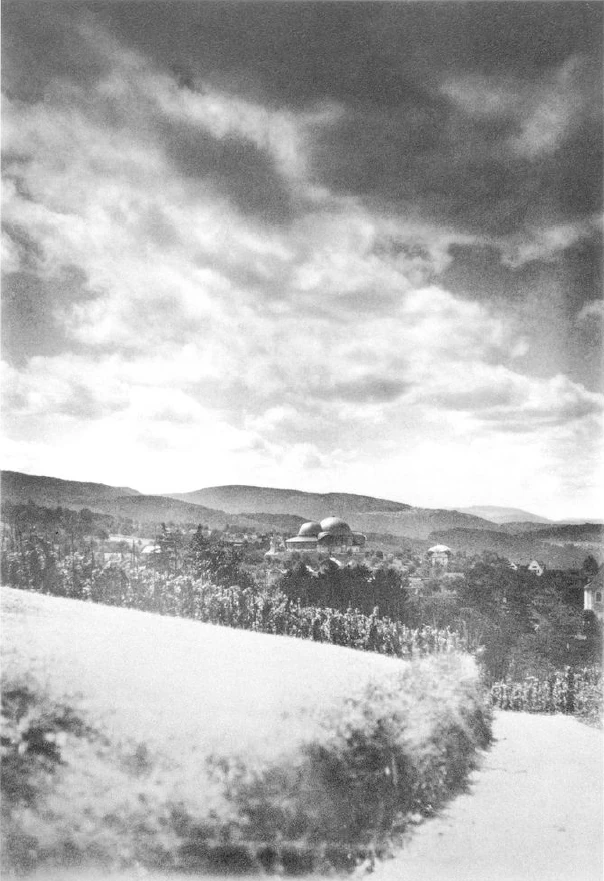
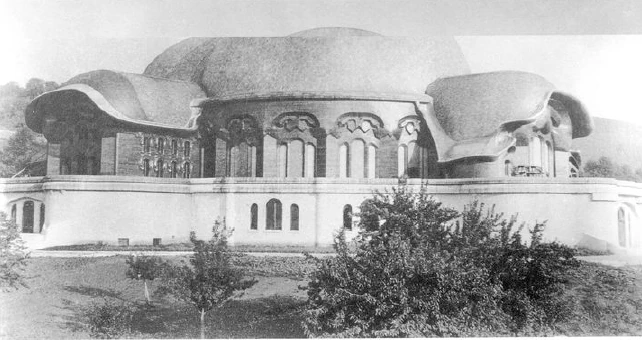
Of course, I must not fail to mention that in recent years numerous friends, particularly from this or that scientific field, have now found each other from almost all scientific fields, who have seen through and recognized how natural science, mathematics, history, medicine, jurisprudence, sociology, and the most diverse fields can be fertilized by anthroposophical spiritual science. So that a real Universitas must attach itself to Dornach, and for this the building, for which we have been able to provide for the time being, is nothing more than a large lecture hall, with the possibility of working in this lecture hall, which is intended for about a thousand people, in other ways than through the mere word.
That the building has this dualistic form, I would say, consisting of two cylinders crowned by hemispheres, can be sensed from the whole task that spiritual science, as we understand it in Dornach, must set itself. After all, this is based on what is called inner human development. One does not arrive at this anthroposophical spiritual science by merely using one's ordinary everyday power of judgment - although, of course, full reliance is placed on this - or by using the ordinary rules of research; but rather by
you must bring to the surface the powers slumbering in the soul, as described in my book “How to Know Higher Worlds”, and really ascend to that region where the supersensible powers and entities of existence reveal themselves to you. This revealing of the supersensible world to the sensory world, which expresses itself in the fact that the thousand listeners or spectators sit there and on the other side exactly that which gives knowledge of supersensible worlds is communicated, this whole thing, transformed into feeling, expresses itself in the double-dome building in Dornach. It is not meant to be symbolic in any way. That is why I can also say: Of course one could also express this thought differently, but that is how the artistic expression of this basic thought presented itself to me at the time when it was needed.
In a sense, by approaching it from the environment, in the external form of the wooden structure growing out of the concrete, which is a double dome, one sees in the configuration, in the design of the surfaces, what is actually meant by anthroposophically oriented spiritual science. The fact that they really tried not to calculate with abstract concepts, but with artistic perception, may become clear to you from the fact that - in the time when it was still possible before the war - Norwegian slate was obtained with all possible efforts to cover the two domes. Once, when I was on a lecture tour in 1913 between Christiania and Bergen, I saw the wonderful Voss slate. And this Voss slate now shines in the sunshine from the double domes, so that one actually has the feeling: this greenish-greyish shine of the sun, which reflects itself there, actually belongs in this whole landscape. It seemed to me that the care that had been taken to bring out the shine of the sun in the right way in such a landscape was something that showed that account had been taken to present something worthy in this place, which, as a place, as a locality, has something extraordinary about it.
I will now take the liberty of showing you a series of slides of what has been created as this Goetheanum in Dornach. They are intended to show in detail how what I have just explained, how the Dornach building idea has actually been realized. The Dornach building idea should present the same thing to the beholder in the outer spatial form in the picture, as it unfolds to the listener through the word, so that what one hears in Dornach is the same as what one sees in Dornach. But because it should really present a renewal out of spiritual life, a renewal of everything scientific, it also needed, in a sense, a new art.
Now the first picture (Fig. 4): You see here the building, the dome is somewhat covered here, here the concrete substructure. When one approaches via a path that leads from the northwest towards the west gate, one has this view. This is therefore the concrete substructure with the entrance; here one goes in first. Further back in this concrete building are the storage rooms. After you have taken your things off, you go up the stairs that lead through this room, to the left and right, and first come to a vestibule – which you can also enter from the terrace through the main gate – and from there to the auditorium. Here you see, starting from this terrace and going up, the wooden structure covered with Nordic slate (Fig. 10). You can see from the shape above the main entrance in the west that an attempt has been made to incorporate something here that really does look like an organic form growing out of the whole of the building. It is not some random thing found in the organic world, copied from nature, but an attempt to explore organic creation itself. The aim is to devote oneself to organic creation in nature in order to have the possibility of forming such organic forms oneself and to shape the whole into an organic form without violating the dynamic laws. I would like to emphasize: without violating the dynamic or mechanical laws.

Anyone who studies interior architecture with us in Dornach will see everywhere that, despite the fact that columns, pillars and so on are organically designed, it is precisely in this organic design that what is properly supported and properly weighted is expressed, without it being expressed in the thickness of the columns or in the heaviness of any load. The correct distribution of load and support is achieved without the aid of organic forms, so that one has the feeling, as it were, that The building feels both the load and the support at the same time. It is this transition to the appearance of consciousness, as it is in the organic, that had to be striven for in this building, out of the anthroposophical-spiritual-scientific will. So without in any way violating the mechanical, geometric, symmetrical laws of architecture, the form should be transformed into the organic.
The next picture (Fig. 5): Here you see the concrete structure from a slightly further point and more from the west front; here the terrace, then the main entrance. The same motif appears here. The second dome, the smaller one, which is for the stage, is covered here; on the other hand, you can see, as it were, what is adjacent to it. Where the two domed structures connect, there are transverse structures on the left and right with dressing rooms for the actors in mystery plays or eurythmy performances, or offices and the like. These are therefore ancillary buildings here. We will see in a moment in the floor plan how these ancillary buildings fit into the overall building concept.
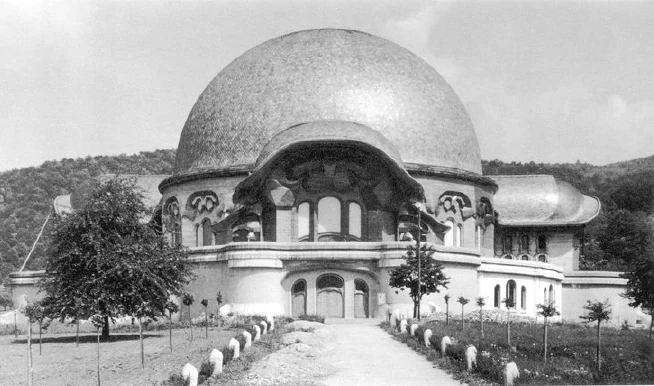
The next picture (Fig. 7): Here you see the building from the southwest side: again the West Gate, the great dome, another tiny bit of the small dome, to the south the southern porch; here the whole front between west and south.
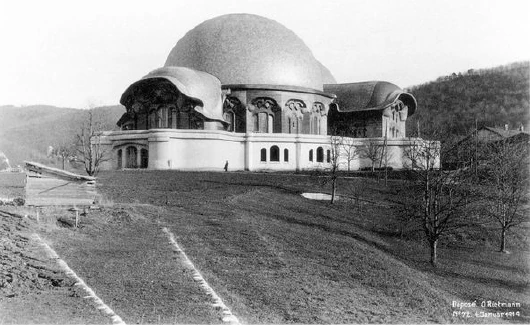
The next picture (Fig. 3): Here you see the two domed rooms, the auditorium, from the other side, from the northeast, one of the transverse buildings from the front, here the small domed room and here the storage rooms that adjoin the small domed room to the east; furthermore, the terrace, and below the concrete building. This is the porch that leads to the west gate, which you have just seen.
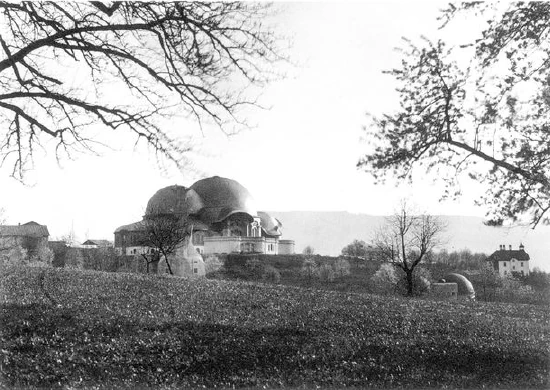
The next picture (Fig. 2): This is the strange building that is particularly heavily contested. This is what you see when you look at the building from the northeast side: you then see this heating and lighting house. It is also the case that one was obliged to form something out of the brittle concrete material, and that one said to oneself, out of artistic laws, out of artistic feelings: There I am given everything that is necessary as a lighting machinery, as a heating machinery: that is the nut kernel to me, around which I have to form the nutshell, to form the necessary for the smoke outlet. It is, if I may express myself in such a trivial way, this principle of the formation of the nutshell is fully implemented. And anyone who complains about something like that should consider what would be there if this experiment had not been carried out, which may still have been imperfectly successful today. There would be a red chimney here! A utilitarian building should be created in such a way that one first acquires the necessary sense of material and then finds the framing from the determination.

The next picture (Fig. 20): Here I take the liberty of showing the layout of the whole. The main entrance from the west: you enter the auditorium through a few vestibules. This auditorium holds chairs for nine hundred to a thousand listeners or spectators. Here you can see a gallery that is closed inwards by seven columns on each side. Only one thing is symmetrical here: namely, in relation to the west-east axis. This is the only axis of symmetry. The building's motifs are only designed symmetrically in relation to this axis of symmetry, the east-west axis; otherwise there is no repetition. Therefore, the columns are decorated with capital and base motifs that are not the same, but are in progressive development. I will show this in detail later. So if you have a first column on the left and right, a second column on the left and right, the capital and base are always the same as those of the right column when viewed from the left, but the following columns always have different capitals, different bases and different architrave motifs above them (Figs. 33-54).
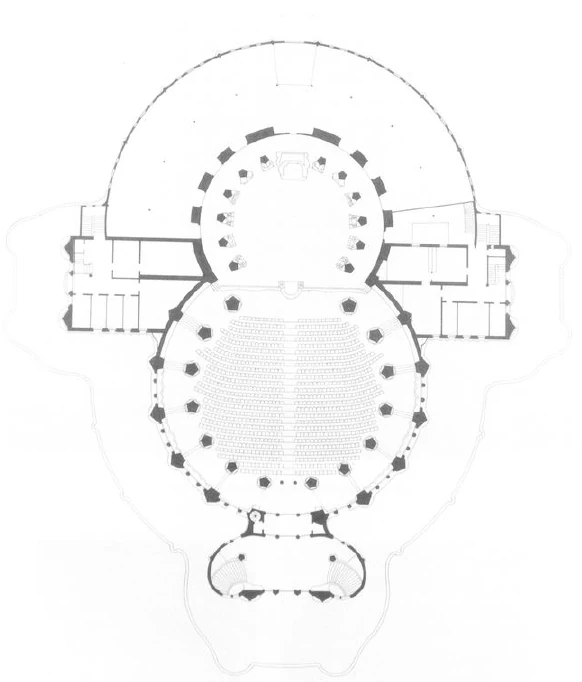
This is absolutely the case, and it has emerged as a necessity from organic building. And this is based on an artistic interpretation of Goethe's principle of metamorphosis. Goethe has indeed developed this metamorphosis theory - which, in my firm conviction, will still play a major role in the science of the living - in an ingenious way. Anyone who still reads his simply written booklet “Attempt to Explain the Metamorphosis of the Plant” from 1790 has before them a grandiose scientific treatise that, according to today's prejudices, simply cannot be sufficiently appreciated. If one wants to express it simply, one must say: Goethe sees the plant as a complicated leaf. He now begins with the lowest leaf, which is closest to the ground, follows the leaves upwards to the heart leaves, which are shaped quite differently than the foliage leaves, then the petals, which are even colored quite differently, then the stamens and pistils, which are shaped quite differently. Goethe says: “Everything that appears in such seemingly different metamorphoses in the leaves of the plant is such that it can be traced back to an ideal similarity and only appears in different metamorphoses for the external sense impression. Basically, the plant leaf always repeats the same basic form; only in the external sensual perception is the ideal similarity differently formed, metamorphosed.
This metamorphosis is the basic principle in the formation of all life. This can now also be applied to artistic forms and creations, and then one can do the following: First you shape the simplest capital or the simplest pedestal for the first column that you have here, and then you surrender, as it were, to the creative forces of nature, which you first tried to listen to – not with abstract thought, but with inner sensation, which, with a will impulse, has listened to a part of nature's creation. And then one tries to create a somewhat more complicated motif of the second column from the simple motif of the first column, just as the leaf a little higher on the plant is more complicated than the one before, but represents a metamorphosis. So that all seven capitals are actually derived from each other, growing out of each other metamorphically, like the forms of the leaves that develop one from the other in the plant's growth, forming metamorphically. These capitals are thus a true recreation of nature's organic creation, not simply repeating the same motif, but rather the capitals are in a state of continuous growth from the first to the seventh.Now, of course, people come and see seven columns – deep mysticism! Yes, there are definitely members of the Anthroposophical Society who, in all sorts of dark, mysterious allusions, talk about the deep mysticism of these seven columns and so on. But there is nothing in it but artistic feeling. When you arrive at the seventh column, this motif of the seventh column is exactly the same as that of the first column – if you really create as nature has created – as the seventh is to the first. And just as the first motif is repeated in the octave, the seventh, you would have to repeat the first motif if you were to move on to the eighth.
Here you can see the boundary between the large and small domes; there is the lectern, which can be retracted because it has to be removed when the theater is in use. Here again there are twelve columns in the perimeter, here the boundary of the small domed room, here the two transverse buildings for dressing rooms and so on.
The next picture (Fig. 21): Here I have made a section through the middle. One enters from the west through the vestibules. Here is the stage area, and rising up from here is the auditorium, the rows of seats, again the seven columns, and here the great dome is connected to the small one by a particularly complicated mechanical structure. Here are the storerooms, the concrete substructure, the dressing rooms for taking off clothes. Here you go in, and then there are the stairs; here you come up and there is the main gate through which you enter.
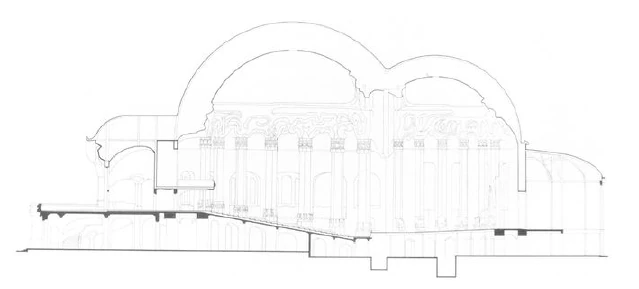
The next picture (Fig. 22): Here I have taken the liberty of presenting my original model in cross-section. The whole building was originally modeled by me in 1913. Here you see the auditorium with its seven columns, the vestibules, here only hinted at the interior of the great dome, which was then painted; here in the small dome room, the capitals everywhere – I will show them in detail in a moment – here the architrave motifs above them; here the plinth motifs, always emerging metamorphically from one another. So, as I said, it is 'only' a line of symmetry, the central axis of the building. Otherwise, no repetitions can be found, except for what is located on the left and right.
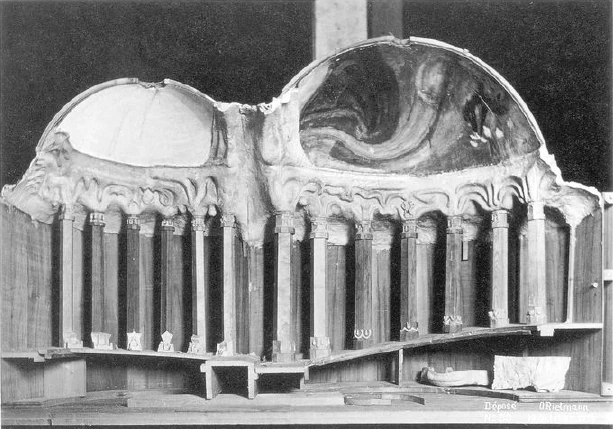
The next picture (Fig. 10): seen from the terrace, the view of the West Gate, the main entrance gate, with two wings, which are necessary [gap in shorthand].

The next picture (Fig. 12): there is such a wing structure, the northern one [seen from the northeast]. Dr. Großheintz's house is also located here, an entire concrete building with about 15 rooms, a family house where I tried to create a residential house out of the concrete material by integrating it into this concrete material. It is near the Goetheanum and was built for the person who donated the land. You can see here how I tried to metamorphose the motif. Everything about this building emerges from the other, like a plant leaf, so to speak, in its form from the other form: it is entirely in the artistic sense the work of metamorphosis.
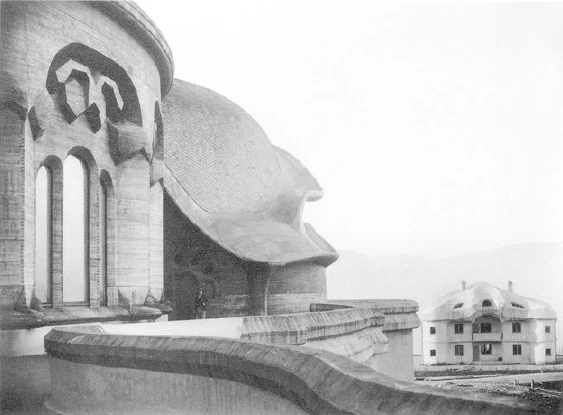
Next image (Fig. 14): This is one of the side wings, the south wing. Here you can see how the motif above the west entrance appears in a completely different form. It is the same idea, but completely different in form. It is just as, say, the dyed flower petal is the same idea as the lowest green leaf of the plant, and yet in external metamorphosis it is something completely different. In this way, one can indeed sense this organic building-thought by living and finding one's way into the metamorphic by giving oneself up to it, but understanding it in a feeling-based way, not in an abstract, intellectual way. This should not actually be explained, but everything should be given by the sight itself.
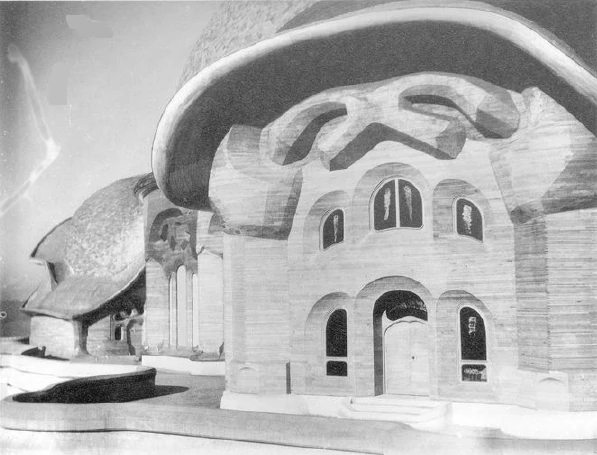
Once the building is finished, those who are familiar with the anthroposophical attitude and feeling will not perceive the building as symbolic at all, but as something that flows from this overall attitude. Of course one would say that it should flow out of the “generally human”; but this generally human is only a foggy and fanciful construct, a fantasy. The human is always the concrete. Someone who has never heard of Christianity naturally does not understand the Sistine Madonna either. And someone who has no sense of Christianity would never understand the Last Supper in Milan in the church of Santa Maria delle Grazie. It is certainly possible to use language to imagine what was given, but apart from that, there is nothing symbolic about the entire structure; all the forms are metamorphosed variations of one another.
Next picture (Fig. 11): Here you see such a lateral transverse structure, viewed from the front, that is, here from the south side. Up here in a substantially modified metamorphosis is the motif that is also above the west entrance. All these motifs are in various metamorphoses, so that the whole architectural idea is carried out organically. Likewise, if you were to study the columns, you would find a basic form, and this is always metamorphosed, just as, in the end, the skull bones of humans are a metamorphosed transformation of the bones of the spinal cord, as everything in the organism is a metamorphosed transformation right down to the last detail.
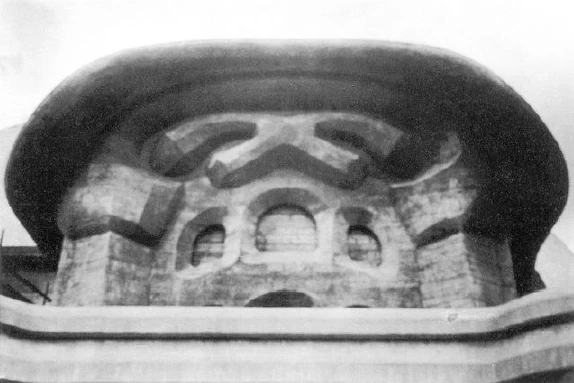
The upper part (Fig. 14) of the southern transverse structure seen on its own; this motif, which was just a little smaller there, is now a little larger.
Next picture (Fig. 23): Here you can see part of the staircase. You would enter through the main entrance below, into the concrete building, and go up these stairs. Here you can see the banister and here a pillar. On this pillar you can see how the attempt is made to shape the supporting pillar in an organic form, how the attempt is made to give the pillar the form that it must have after the opposite exit, because there is little to carry; the form that it must have where it is braced, where the entire weight of the staircase lies. Of course, something like this can only be formed geometrically. But here, for once, an attempt should be made to shape the whole thing as if it were alive, so that, as it were, the glow of consciousness of bearing and burdening lies within; with every curve, everything is precisely and intuitively measured for the place in the building where it is located.

Especially if you look at this motif here (Fig. 24): there are three half-circular channels on top of each other. Believe it or not, but it is true: when someone goes up there and enters the auditorium, they must have a certain feeling. I said to myself, the one who goes up there must have the feeling: in there, I will be sheltered with my soul, there is peace of mind to absorb the highest truths that man can aspire to next. That is why, based on my intuitive perception, I designed these three semicircular channels in the three perpendicular spatial directions. If you now go up these stairs, you can experience this feeling of calm. It is not modeled on it – it is not that at all – but only later did I remember that the three semicircular channels in the ear also stand in these three directions perpendicular to each other. If they are violated, a person will faint: they are therefore connected with the laws of equilibrium. It was not created out of a naturalistic desire for imitation, but out of the same desire, which is modeled on the way the channels are arranged in the ear.
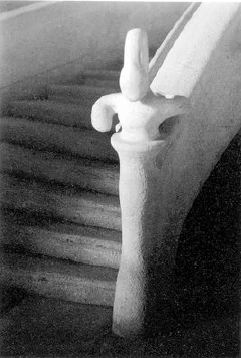
You enter from the west side, go up the stairs, here are the three perpendicular semicircular canals, and here again these pillars. Of course, it often happens in life – I have experienced it many times – that when people in a city have seen an actor or actress in certain roles, and later another actor or actress has come along who could be good, better, more interesting or different, they judge them based on the earlier ones. If they did everything exactly like the earlier ones, they were good; if they did it differently, they were bad, no matter how good they might be in themselves. And so, of course, people judge such a thing according to what they are accustomed to, and do not know that when something like this is erected, every effort is made to make it look as if it were supported in different ways on different sides, and that this is derived from the overall organic structure of the building. Some found it thin and called it rachitic, others thought it resembled an elephant foot, but could not call it an elephant foot either, and so someone came up with the name “rachitic elephant foot” based on their own intuitive feeling. This is what happens so often today when some attempt is made to bring something new out of the elementary.

Next image (Fig. 27): If you go up the stairs, you will come to the vestibule before entering the large domed room. Here you can already see the beginning of the timber construction. At this height, there would be a concrete terrace, with the concrete structure below. You can see from this column how the capital, with all its curves, is precisely adapted to the location, not just schematically in space, but dynamically. The curves at the exit have to express a different form of support than those on the opposite side of the building, where the columns have to brace against them. That is why all these wooden forms, column capitals, architraves and so on had to be made by our friends from the Anthroposophical Society over many years of work. All this is handcrafted, including, for example, the ceiling, which does not have just any schematic form, but is individually designed on all sides in its curves and surfaces, hollowed out differently in one spatial direction than in the other spatial direction. And all this according to the law, just as the ear is hollowed out differently at the front than at the back, and so on.

Next picture (Fig. 30): Now we have entered and are standing in the room that is the auditorium. If we turn around and look backwards, we see the organ room here, which you can see in more detail in other pictures. But here you only have the model, not as it can be seen now in the building, where a lot has been added. I have tried to integrate this organ in such a way that one does not have the feeling that something has been built into the rest of the space, but rather that at this point what is presented here as the organ case and the organ itself has literally grown out of the whole. That is why the architecture and sculpture are adapted to the lines created by the rest, i.e. the organ pipes and so on.
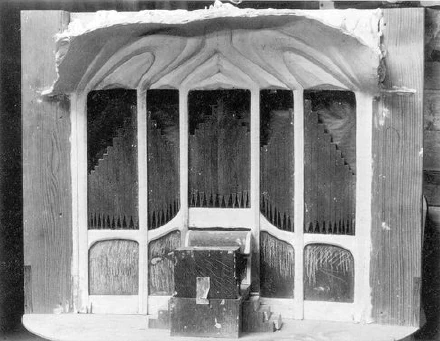
Next image (Fig. 28): You are now, so to speak, in the auditorium, looking from the auditorium at the columns. Here is the organ motif, here are the first two columns with their capitals. We then come to the altered, metamorphosed capitals of the second, third, fourth columns and so on – I will show this in detail in a moment – above them always the architrave motif and below the base motif. Next image (Fig. 29): The pictures were taken at different times. The construction has been going on since 1913, when the foundation stone was laid, and the pictures show it in various stages. Here again, if you turn around in the auditorium and look to the west, the upper part, the organ motif; the first and second columns with capitals on the left and right, the capitals and the architraves above them are quite simply designed. In the following, I will show one column and the one that follows, and then each column with the column capital on its own, so that you can see how the following column capital always emerges metamorphosically from the preceding one. This particularly emphasizes the fact that, basically, the individual column cannot be judged on its own, but only the entire sequence of columns in their successive form can be judged.
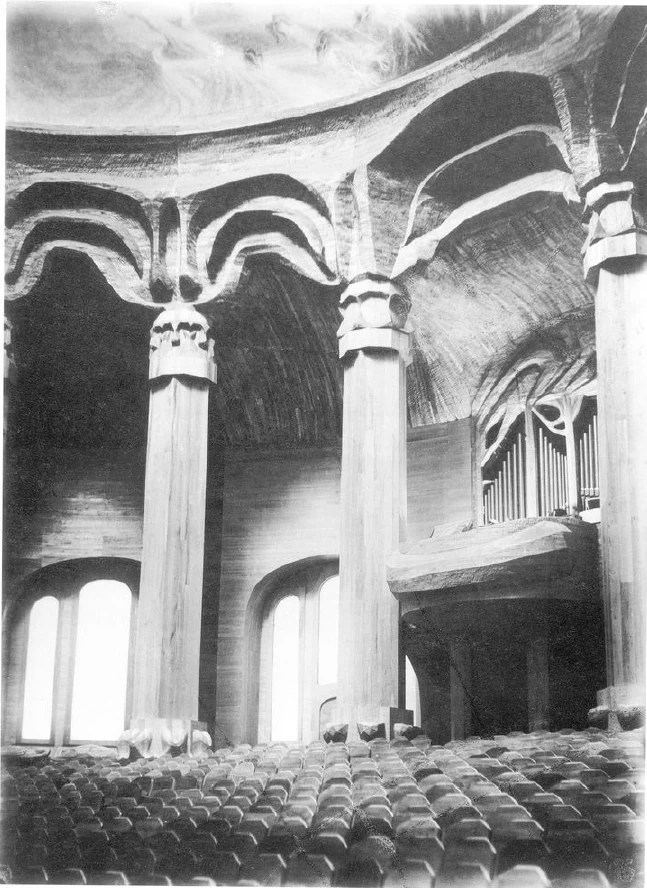
Next image (Fig. 34): Here you see the first column by itself, simply from bottom to top in the forms, simply from top to bottom. You see a very simple motif.
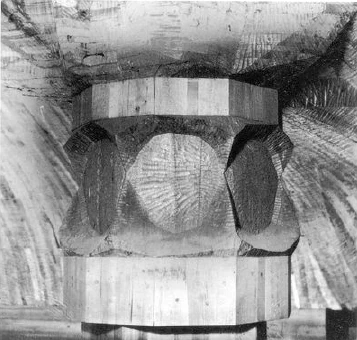
Next image (Fig. 35): Here you see the first motif, the first capital with the architrave above it; here the second, emerging organically from the first. The motif, which goes from top to bottom, grows; in growing, it metamorphoses, and so does the motif from bottom to top. To a certain extent, one has to feel one's way into the forces that are at work when an upper plant leaf is created in its form, metamorphosed compared to the lower one; in the same way, this first simple plant motif develops into a more complicated one. What matters is that you take the whole sequence of motifs, because each one always belongs with the other; in fact, all seven belong together and form a whole.
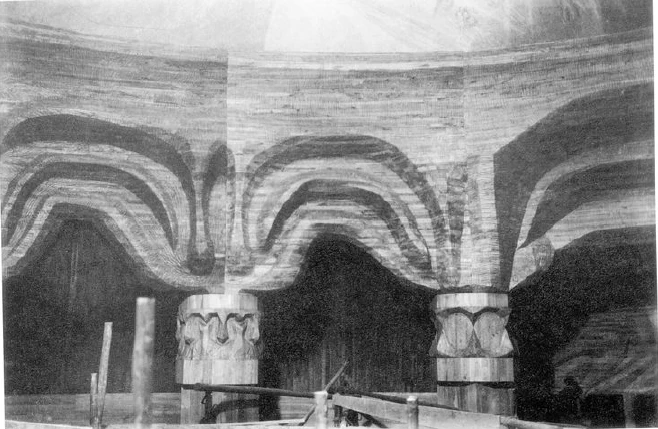
Next image (Fig. 36): Here you see the second column by itself. The next motif always emerges metamorphically from the previous one. I will now show the second and third columns.
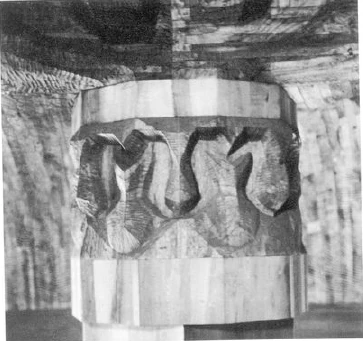
Next picture (Fig. 37): the second and third columns, again the third capital motif with the architrave motif above it is more complicated, so that you really get this complicated form in your feeling if you do not want to explain it symbolically or approach it with some intellectual things, but with feeling. Then you will see the emergence of one from the other.
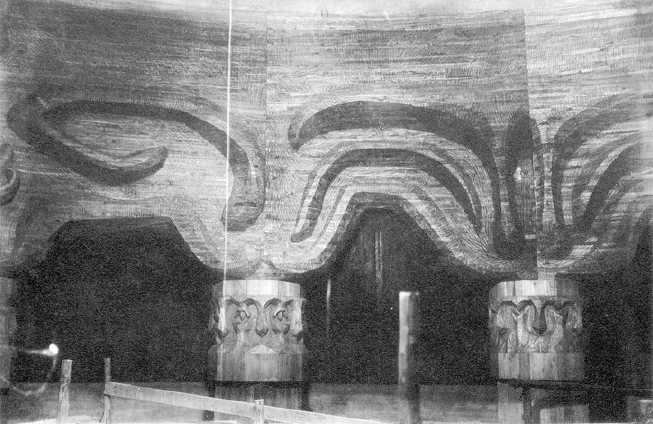
Next image (Fig. 38): The third column by itself.
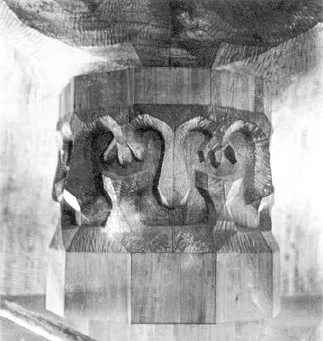
Next image (Fig. 39): The third and fourth columns, that is, the capitals of these with the architrave motif. Here one could believe that the search was for this architrave motif to form a kind of caduceus. But it was not sought, it is simply sensed, as these meeting forms, when they continue to grow, continue to complicate, as they become there, and then the sensation of this motif, which resembles the caduceus, arises by itself. Likewise, as if this continues to grow: from bottom to top, things simplify, from top to bottom they complicate; then this form arises, which I will now show again in isolation.
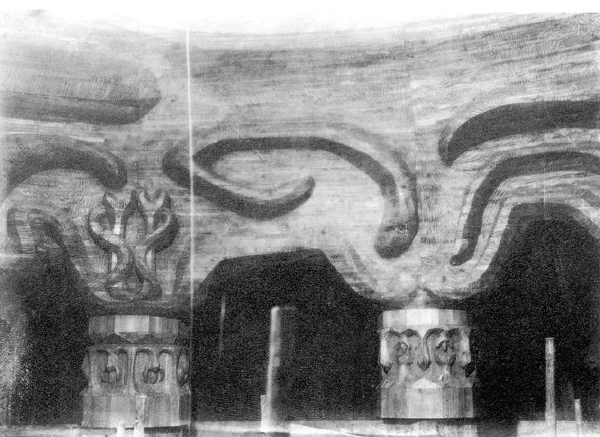
Next image (Fig. 40): The fourth column.
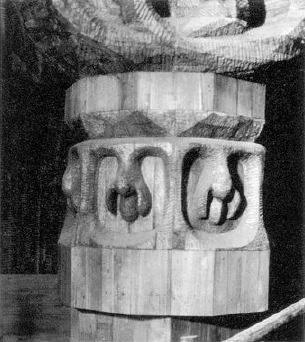
Next image (Fig. 41): The fourth and fifth column. As can be seen from this, if you imagine it growing downwards, this form emerges, and it becomes simpler from the bottom up, and I would say that it grows in a more complex form upwards. That is the strange thing! When you think of development, you believe, from a certain false idea of development that has gradually formed, that development proceeds in such a way that you first have a simple thing, then a more complicated one, and then an increasingly complicated one, and that the most perfect thing is the most complicated. If you now put yourself in the right place in the developmental impulses with artistic perception, you see that this is not the case at all; that you must indeed advance from the simple to the more complicated; but then you arrive at the most complicated in the middle of the development, and then it becomes simpler as it approaches the more perfect.
That was, my dear attendees, while I was working on the models for these things, an extraordinary surprise for me. I had to go from the simple to the complicated - you see, we are here at the fourth and fifth pillars, so roughly in the middle of the seven pillar forms - and I had to have the most complicated thing in the middle and then go back to the simpler. And if I go back, as nature itself creates, I also find the human eye, but the human eye, although it is the most perfect, is not the most complicated. In the eye of certain lower animal forms, for example, we have the fan, the xiphoid process. The eye of certain lower animal forms is more complicated in some respects than the perfect human eye. In nature, too, it does not happen that one goes from the simpler to the more complicated and then further to the most complicated, but by observing things further, one comes back to the simpler. The more perfect is simpler again. And that turns out to be an artistic necessity in such a creative process.
Next image (Fig. 42): The fifth column in itself.
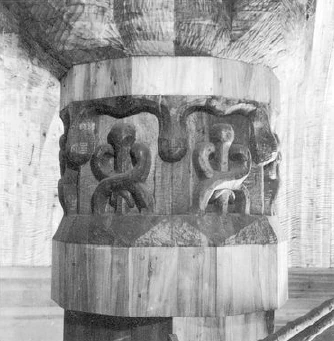
Next image (Fig. 43): Now the fifth and sixth columns. You can see that here the capital of the fifth column is still relatively complicated; if it continues to grow, it becomes simpler again: so that this sixth column, although more perfect in its design, is nobler, is simpler again. The same applies to the architrave motif.
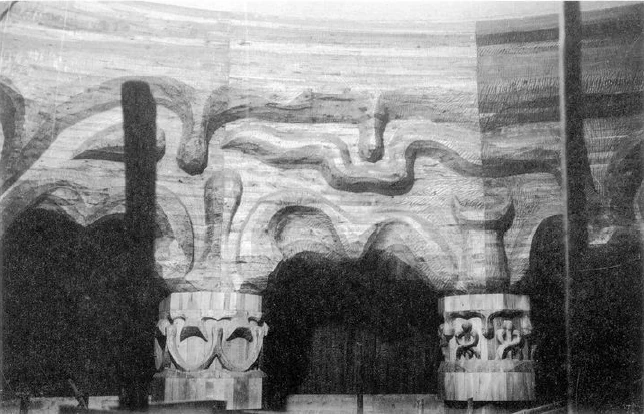
Next image (Fig. 44): This sixth column stands alone.
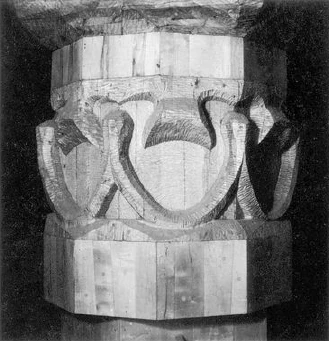
Next image (Fig. 45): Sixth and seventh column, considerably simplified again. Next image (Fig. 46): The seventh column on its own, again simplified.
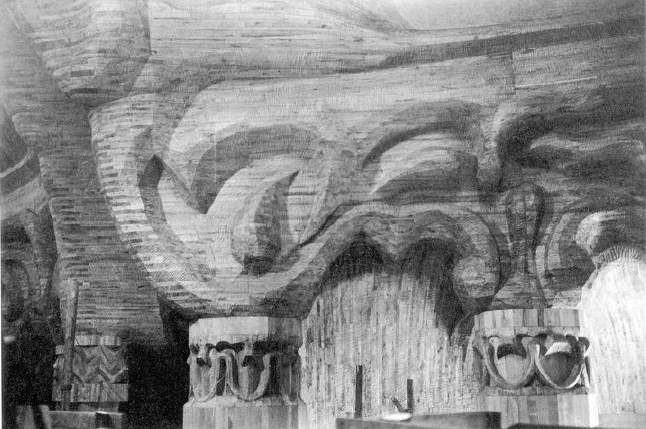
Next image (Fig. 47): This is the seventh column, the architrave motif; here is the gap between the large and small domed rooms; here is the curtain. Then the first column of the small domed room, and here we enter the small domed room.
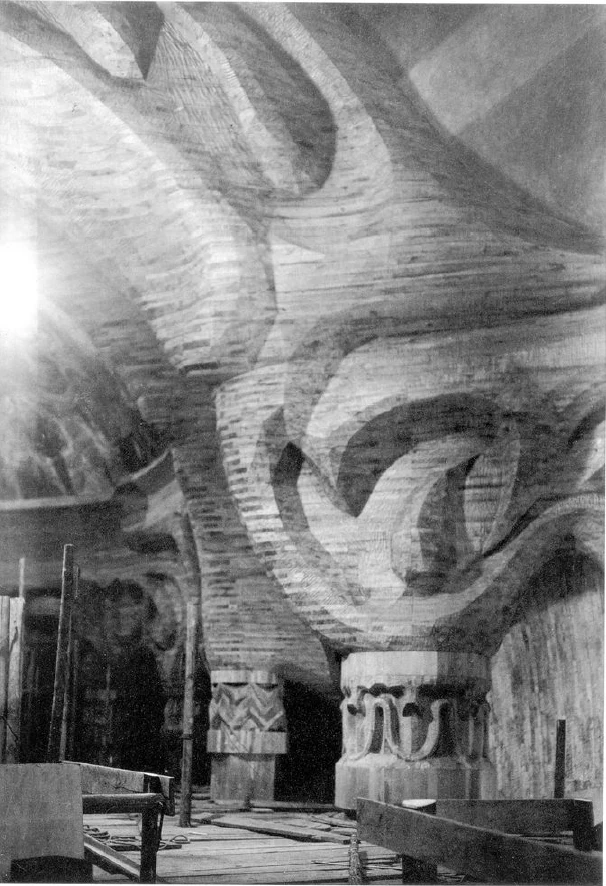
Now that we have gone through the orders of the columns in the large domed room, I will show you the figures on the pedestals, which have also grown out of each other in a metamorphosing organic way. I will show them in quick succession.
Next image (Fig. 48): Here I show the figures on the pedestals in succession. First pedestal.
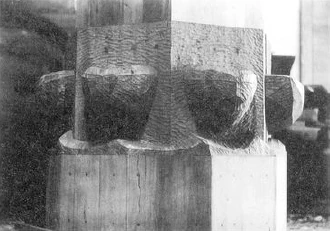
Next image (Fig. 49): Each one always emerges metamorphically from the other: Second plinth.
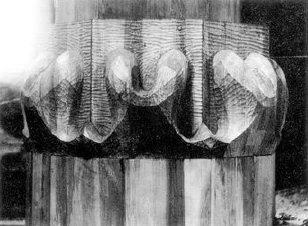
Next image (Fig. 50): If you now imagine the changes, this is what happens: Third base.
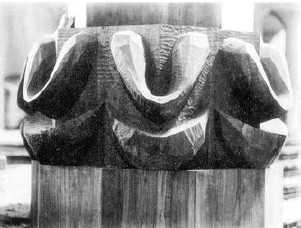
Next image (Fig. 51): Fourth pedestal, again more complicated. And now the simplifications begin with the pedestal figures, in order to arrive at perfection.
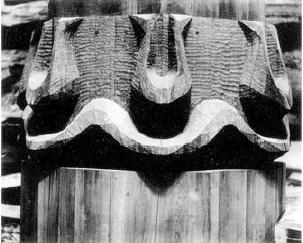
Next image (Fig. 52): Fifth pedestal. Next image (Fig. 53): Sixth pedestal. Next image (Fig. 54): This seventh pedestal figure is relatively simple again.

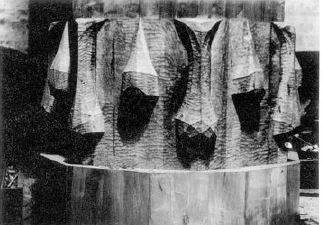
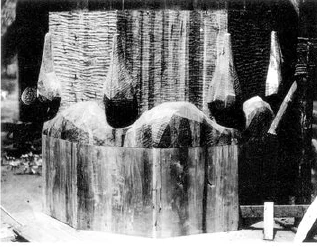
Next image (Fig. 55): Now, here you can see into the small dome room from the auditorium. You can still see the last column of the auditorium, then the columns and architraves of the small dome room. That is the end of the large dome room, here the center of the small dome room. Here, a kind of architrave is formed between the two central columns of the small dome, but [above it] is not some kind of symbolic figure. If you want to see a pentagram in it, you can see it in every five-petalled flower. We have [below] synthetically summarized all the lines and curves that are distributed on the individual columns. Above, the small dome is then painted. I will have more to say about this coloring.
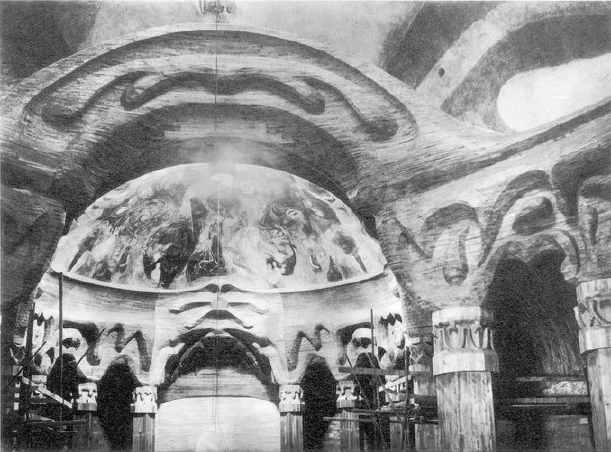
The next picture (Fig. 56): individual columns of the small domed room. Here the gap [for the curtain]. It is seen here on the left when entering from west to east. Here is the architrave of the small domed room. Here, as you can see, the capitals of the large domed room are not repeated, they correspond to the overall architectural concept. Since the small dome room is smaller and every organ that is smaller in the organic context also has different forms, this is also clearly evident here in the formation of the whole.
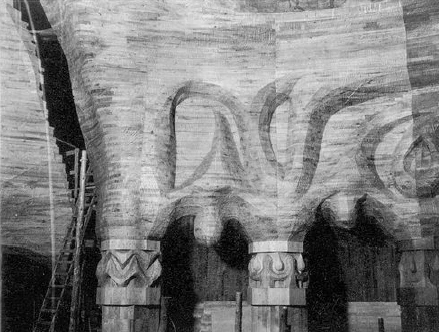
The next picture (Fig. 64): Here again is the view into the small domed room, the last two columns of the large domed room; the same motif that you have just seen in a different aspect, and here the small dome. Of course, nothing of the paintings can be seen here, only the situation could be hinted at. The bases of the small columns have been converted into seats.

The next picture (Fig. 67): Here the orders of columns continue to the left and right; this is in the middle in the east, directly under the small domed room, where all the lines and curves found elsewhere are synthetically summarized in the most diverse forms. This is a kind of architrave, a central architrave; below it is the group I will talk about, a nine-and-a-half-meter-high wooden group, the central figure of which represents a kind of human being. Above it is the small domed room.
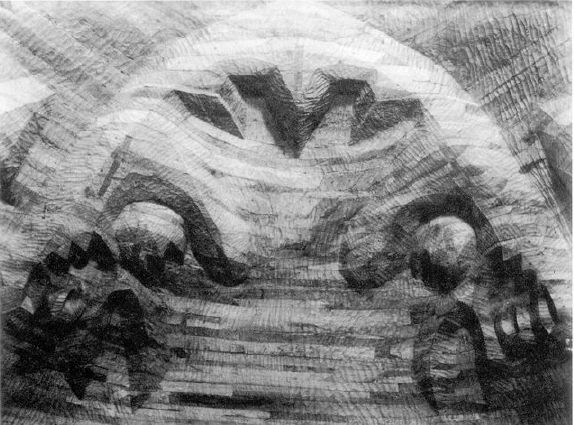
The next picture (Fig. 69): We now come to the painting of the small domed room. Now, by speaking to you about the painting of the small domed room, I can only show you the pictures of this small domed room. In the painting of the large domed room, I have not yet fully succeeded in doing this, but in the painting of the small domed room, I have tried to realize to a certain extent what I had a character in my mystery dramas express about the new painting: that the forms of color should be the work, that is, that one should really pull oneself together to fully perceive the world of color as such.
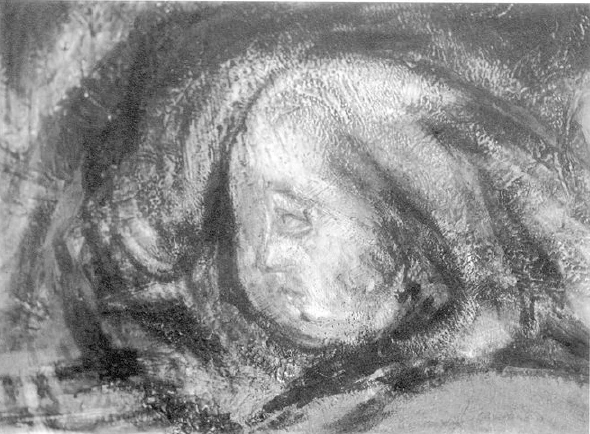
Dear attendees! If you look at the world of colors, it is indeed a kind of totality, a world of its own. And if you feel very vividly into the colorful, then I would say red and blue and yellow speak to each other. You get a completely lively feeling within the world of colors and you get to know, so to speak, a world of colors as an essential one at the same time. Then drawing stops, because in the end you perceive drawing as something insincere. What then is the horizon line? If I draw it with a pencil, I am actually drawing an untruth. Below is the green surface of the sea, above is the blue surface of the vault of heaven, and when I put these down as color, the form arises, the line arises as the boundary of the color.
And so you can create everything out of the colored that you essentially want to bring onto the wall as painting – be it the wall of the spheres as here or the other wall. Do not be deceived because there are motifs, because there are all kinds of figures on it, even figures of cultural history. When I painted this small dome, it was not important to me to draw these or those motifs, to put them on the wall; what was important to me was that, for example, there is an orange spot here in different shades of orange: the figure of the child emerged from these color nuances. And here it was important to me that the blue was adjacent: the figure emerged, which you will see in a moment. It is definitely the figure, the essence, drawn entirely from the color. So here we have a flying child in orange tones, here would be the gap between the large and small domed rooms, and the child is, so to speak, the first thing painted on the surface of the small dome. But by seeing these motifs, you will best understand the matter if you say to yourself: I can't actually see anything in it, I have to see it in color. Because it is felt and thought and painted entirely out of color.
The next picture (Fig. 70): Here you see the only word that appears in the whole structure. There is no other inscription to be found anywhere; everything is meant to be developed into art, into form. But here you will find the “I”. Out of the blue, a kind of fist figure has emerged, that is, the 16th-century human being. The whole cognitive problem of modern man has really emerged from the perception of color before the soul. This cognitive problem of modern man can only be perceived in the abstract, if one perceives as it is often portrayed today; it is different from what we can grasp of natural laws today.
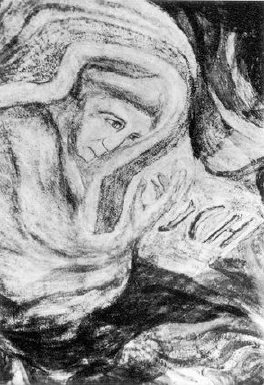
It [the problem of knowledge] intrudes into our soul when we do not merely view things scholastically as abstractions, but when we strive with our whole being to immerse ourselves in the riddles and secrets of the world, as we must in order to be fully human, in order to become aware of our human dignity. Then it places itself beside the striving human being, the one striving for knowledge, who in Faust really, I would say, strives out of the mysterious, mystical blue, strives for the fully conscious I that speaks. The older languages have the I in the verb; for this epoch one is justified in letting a word appear; otherwise there is no word, no inscription or the like in the whole structure, everything is expressed in artistic forms. But the child and birth, and the other end of life, death, are placed alongside the person striving for knowledge. Above it would be the Faust figure you have just seen, below it Death, and further over towards us this flying child. This skeleton here (Fig. 71) in brownish black, in the Faust book in blue, the child (Fig. 72) in various shades of orange and yellow.
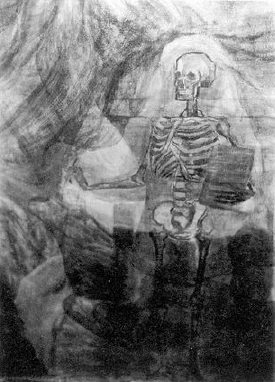
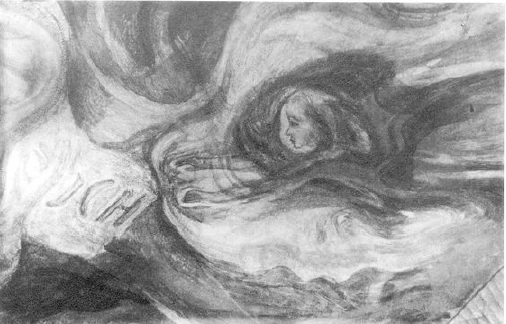
The next picture (Fig. 73): Here you see a compilation: below the skeleton, here Faust, here this child, whom you saw individually, above it a kind of inspirer, an angel-like figure, which I will show as an individual, then other figures join here. As I said, the necessity arose for me to depict the striving of the people of the last centuries from the color surfaces that I wanted to place in just that position. Here then is the striving of the Greeks. You will see it in detail.
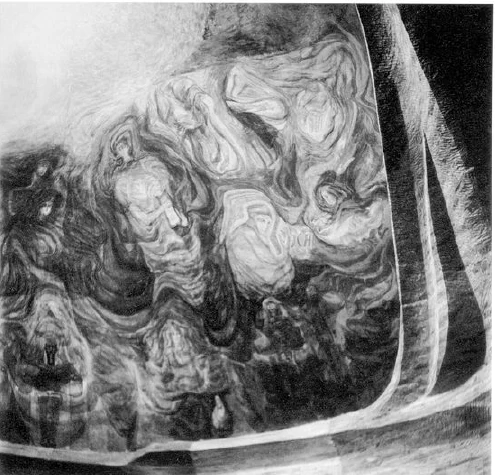
The next picture (Fig. 74): the genius in blue-yellow, who is above the fist-shape, as if inspiring the fist-shape from above. We would then come across the striving child. The next picture (Fig. 75): then a kind of Athena figure, taken out of a brownish-orange with light yellow. It is the way in which Greek thinking has become part of the whole world of knowledge and feeling. This figure that we have here is inspired by a kind of Apollo figure, just as Faust was previously inspired by his angel (Fig. 76); this brings us back to Greek thinking.
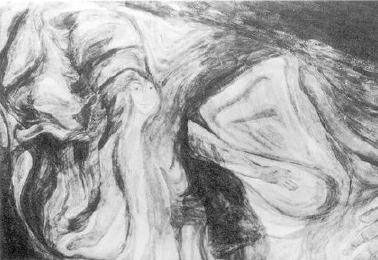
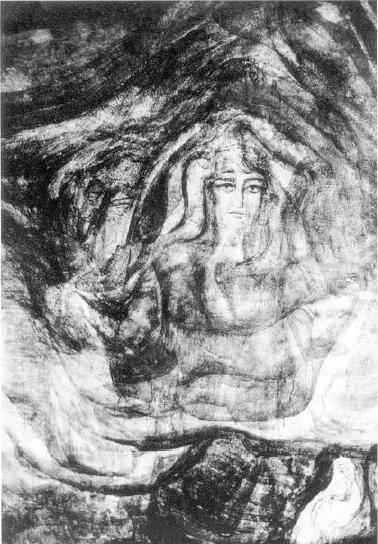
The next picture (Fig. 76): The inspiring Apollon. Particular care has been taken here with the bright yellow, through which this Apollo figure has been created out of color. I tried to give this bright yellow a certain radiance through the type of technical treatment.
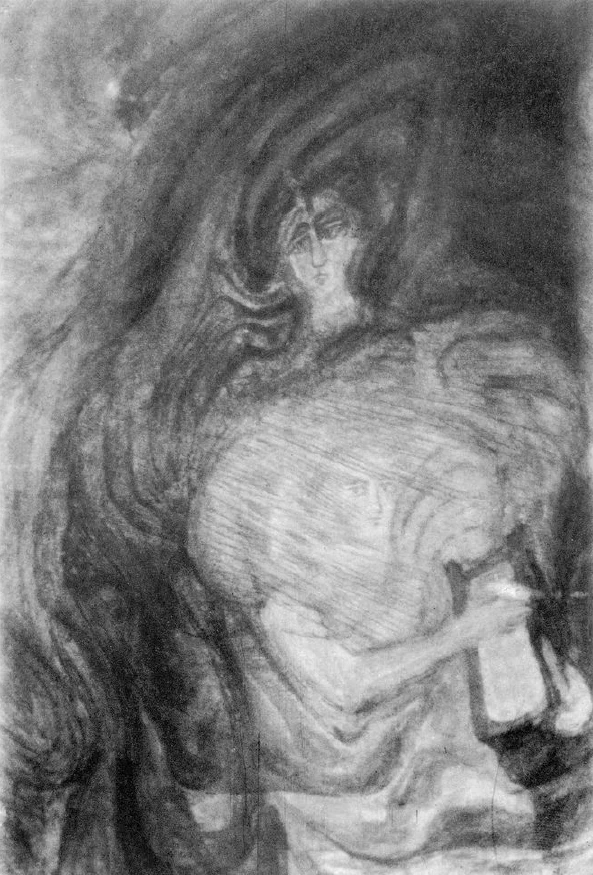
The next picture (Fig. 77): Here you see two figures, which now inspire the Egyptian initiate, who recognizes the tables and feels the world. The man on the right is depicted in a somewhat darker color, I would say a reddish brown, and the Egyptian initiate, who is below him, is also depicted in this way.
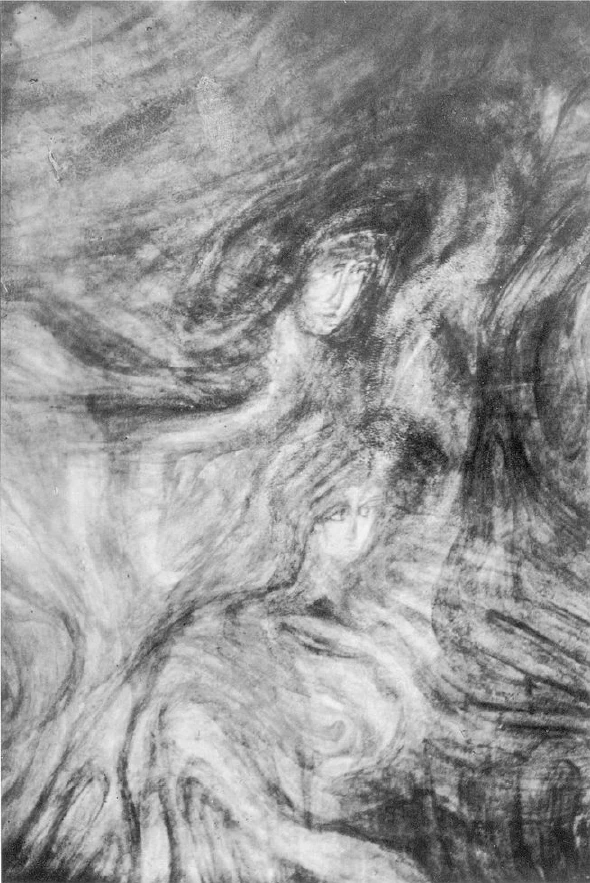
The next picture (Fig. 78): The Egyptian knower, that is, the counter-image for those ancient times, which in our case is Faust, who strives for knowledge.
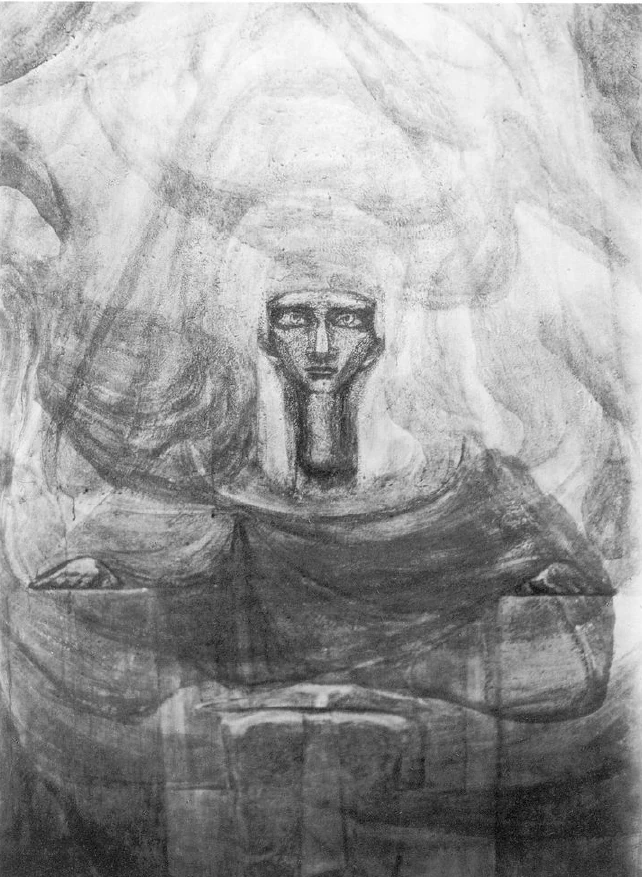
The next picture (Fig. 79): Here you see two figures that I am obliged to always assign certain names to in spiritual science because they keep recurring. One should not think of nebulous mysticism here, but only of the necessity of having a terminology; just as one speaks of north and south magnetism, so I speak of the Luciferic and the Ahrimanic. When we stand face to face with a human being, we cannot grasp his whole being at once, nor with all the powers of knowledge. He has within him two opposing polarities: that which in him constantly strives towards the rapturously false mysticism, false theosophy, that which always seeks to rise above itself towards the unreal , the unfounded, the nebulous - the Luciferic - and that which makes him a Philistine, that which predisposes him to the spirit of heaviness - the Ahrimanic, which is painted here with its shadow. The Luciferic is painted in the yellow-reddish color, the Ahrimanic in the yellow-brownish. It is the dualism of human nature. We can have it physically, physiologically: Then the Ahrimanic in man is everything that ages him, that brings him to sclerosis, to calcification, that makes him ossify; the Luciferic is everything that, when it develops pathologically, brings one to fever, to pleurisy, that thus develops one towards warmth. Man is always the balance between these two. We do not understand the human being if we do not see in him the balance between these two, the Luciferic and the Ahrimanic.
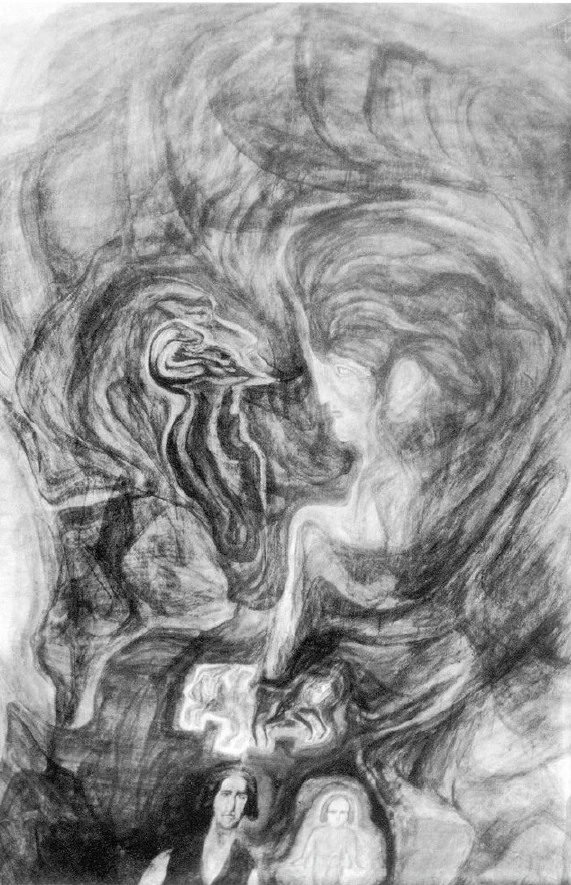
In particular, however, the Germanic-Central European culture that came over Persia is confronted with this duality in its knowledge. Hence the recognizing Central European, who has the child here (Fig. 82) – we will see him in more detail – is inspired by this duality of the Luciferic-Ahrimanic, with which he must come to terms through his inner tragic destiny of knowledge. Here this kind of dualism is seen again in the smaller figure, shaped like a centaur. I painted this during the war, and one sometimes has one's private ideas; the ill-fated fabric of Woodrow Wilson's fourteen points grew out of the abstract transformation of dualism. Here in Switzerland, too, I have repeatedly spoken of the world-destroying nature of these fourteen points: Therefore, I took the private pleasure of immortalizing Mr. and Mrs. Wilson in these figures. But, as I said, this is of little importance.
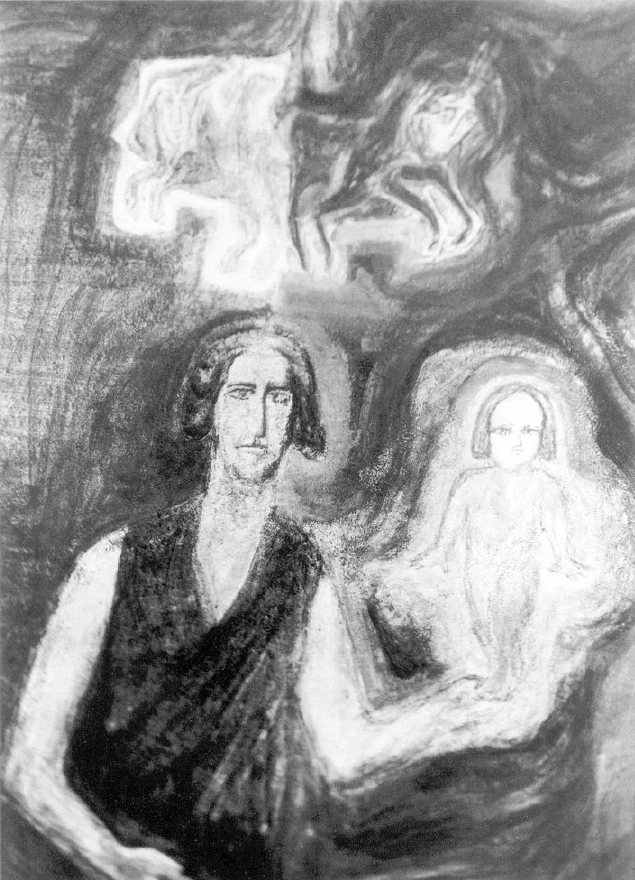
The next picture (Fig. 81): Here you see the Ahrimanic figure brought out and the shadow above it. In spiritual terms, this is everything that drives man to materialism, to philistinism, to pedantry, what he becomes when – be it expressed in the extreme – he has only intellect and no heart, when all his powers, his soul powers, are directed by the intellect. And if man did not have the good fortune that his outer body is more in balance, his outer body would actually be determined by the soul, he would be an exact expression of the soul: All those people who feel materialistically, feel pedantically, who are almost completely absorbed in the intellect, would look like that on the outside. Of course, they are protected from this by the fact that their body does not always follow the soul, but the soul then looks like this when you see it, when you feel it physically.
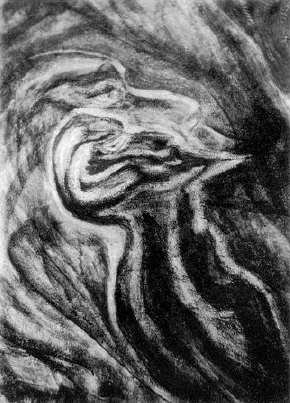
Next image (Fig. 80): The Luciferic, worked out of the yellow, worked out of the yellow into the bright. This is what a person develops when he shapes himself one-sidedly according to the visionary, one-sidedly according to the theosophical, when he grows beyond his head; one often finds it developed in some members of other movements who always grow half a meter with their astral head above their physical head so that they can look down on all people. This is the other extreme, the other pole of man.
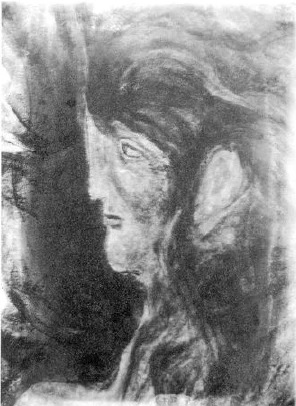
Here at the bottom, so to speak, is the Germanic initiate (Fig. 82), the Germanic knower in his tragedy, which lies in the fact that duality has a particularly strong effect on him: the Luciferic and the Ahrimanic; as an addition, again, the naivety of the child. This is what emerged for the artistic sensibility. It was worked out of the brown-yellow; the child is kept in the light yellow.
Next picture (Fig. 83): Here we are already approaching the center of the domed room. This man would stand here with the child, and further towards the center are these two figures, which are one. Of course, this does not refer to the current Russian culture or lack of culture, which is corrupting people and the world, but rather the Russian culture actually contains the seed for something future. At present it is overshadowed by what has been imported from the West, by what should indeed disappear from the earth as soon as possible if it does not want to drag the whole of Europe with it into the abyss. But at the bottom of Russian nationality lies something that is guaranteed a future. It should be expressed through this figure, which has its double only here. That which lives in Russian nationality always has something of a double about it. Every Russian carries his shadow around with him. When you see a Russian, you are actually seeing two people: the Russian, who dreams and who is always flying a meter above the ground, and his shadow. All of this holds future possibilities. Hence this characteristic angel figure, painted out of the blue, out of the various shades of blue. Above it, a kind of centaur, a kind of aerial centaur. Here this figure, everything in the indefinite, even the starry sky above this Russian man, who carries his doppelganger with him.
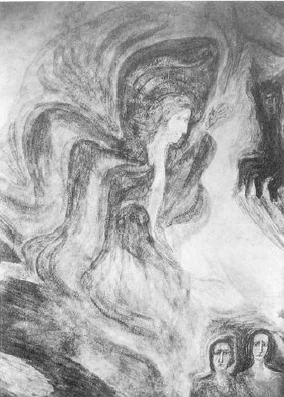
Next image (Fig. 85): We have now passed the center here. This is the same centaur figure – when facing east, located on the left – as the earlier one on the right of the center. This angel figure is the symmetrical one to the one you have just seen. This one, however, is painted in a yellowish orange, and below it would now be the Russian with his doppelganger, but symmetrical to what was shown before.

Next image (Fig. 86): Now we are standing in the middle of the small domed room. Once again, on the other side, the Russian motif. Here, you can see the figure of Ahriman lying in a cave; and here, at the top, the representative of humanity. One can imagine him as the Christ. I have formed him out of my own vision as a Christ-figure. Lightning flashes come out of his right hand and surround Ahriman like the coils of a snake. His arm and hand go up to Lucifer, who is painted emerging from the reddish-yellow.
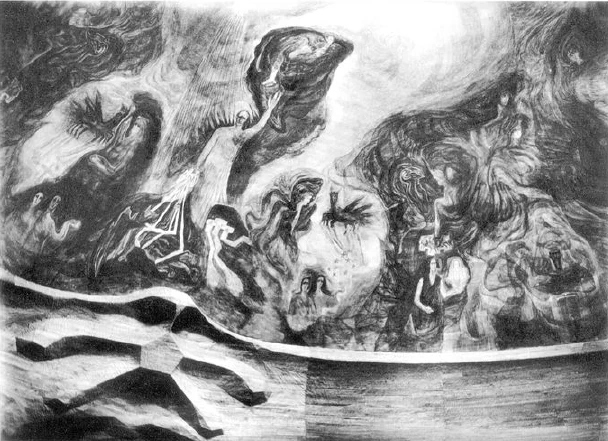
Next image (Fig. 87): Here you can see the figure of Lucifer a little more clearly. Below would be the figure of Christ, reaching up with his arm; this is the face, painted in yellow-red. So it is the Luciferic in man that strives beyond his head, the enthusiastic, that which alienates us from our actual humanity by making us alien to the world, bottomless.
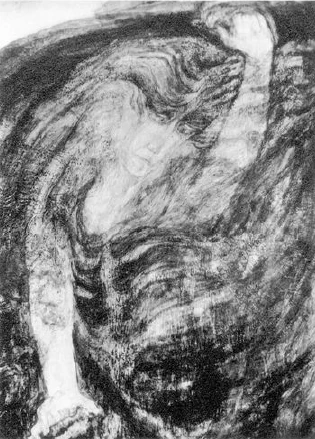
Next image (Fig. 88): Ahriman in the cave. His head is surrounded by lightning serpents that emanate from the hand of Christ, who is standing above them. Here the wing, the brownish yellow, is painted more in the brownish direction, in places descending into the blackish blue.
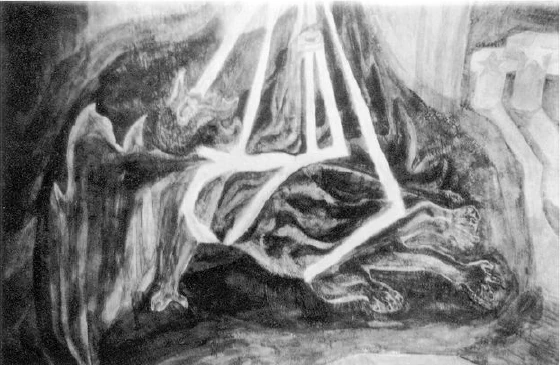
Next picture (Fig. 89): Here I am now showing you my first sketch for the plastic figure of Christ. You see, I tried to make Christ beardless, but Christ pictures have only had a beard since the end of the fifth or sixth century. Of course, no one has to believe me. It is the Christ as he presented himself to me in spiritual vision, and there he must be depicted beardless.
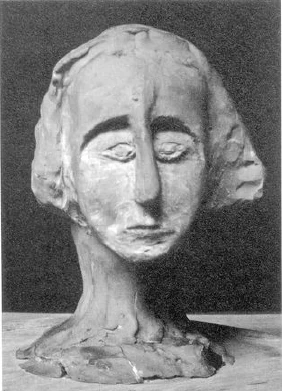
Next image (Fig. 90): The painted head of Christ between Ahriman and Lucifer, the images that I have just shown. Painted in the dome room above is Christ between Ahriman and Lucifer, and below it will later be – it is still far from finished – the nine-and-a-half-meter-high wooden group (Fig. 93), in the middle of which is the representative of humanity, the Christ, with his right arm lowered and his left arm raised, in such a way that this position, like embodied love, is placed between Ahrimanic and Luciferic forces.
, the Christ, his right arm lowered, his left arm raised, in such a way that this position, like embodied love, is placed between the Ahrimanic and the Luciferic. The Christ does not face the two aggressively. The Christ stands there as the embodiment of love. Lucifer is overthrown not because Christ overthrows him but because he cannot bear the proximity of Christ, the proximity of the being that is the embodiment of love.
Next picture (Fig. 92): This is the first model, made in plasticine, for the Christ, en face, that is, for the representative of humanity, who is to stand in the middle of the wooden group (Fig. 93). But I would like to explicitly note that it will not be somehow obvious that this is the Christ; rather, one will have to feel it from the forms, from the artistic aspect. Nothing, absolutely no inscription, except for the “I” that I mentioned earlier, can be found in the entire structure.
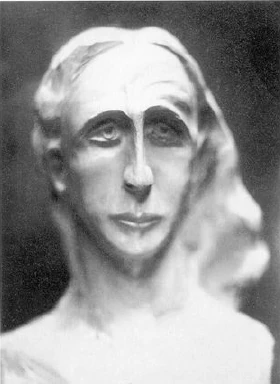
Next image (Fig. 98): This is from the left side of this group of woodcuts [taken from the execution model]: Here is Lucifer striving upwards, and above him a rock creature emerging from the rock, so to speak, the rock transformed into an organ. Here is Lucifer; here Christ would stand; here is the other Lucifer, and that is such a rock creature. It is a risk to make it completely asymmetrical, as asymmetries in general play a certain role in these figures, because here the composition is not conceived in such a way that one takes figures, puts them together and makes a whole – no, the whole is conceived first and the individual is extracted. Therefore, a face at the top left must have a different asymmetry than one at the top right. It is a daring thing to work with such asymmetries, but I hope that it will be felt to be artistically justified if one ever fully comprehends the overall architectural idea.
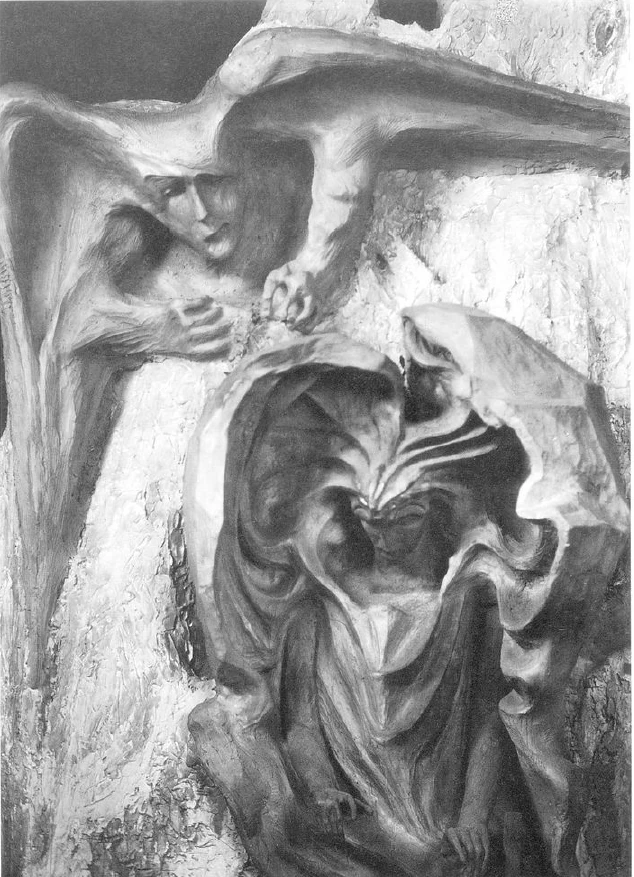
Next image (Fig. 99): Here you can see the model of the Ahriman head. It is the original wax model that I made in 1915. It is an attempt to shape the human face as if the only things present in the human being were the aging, sclerotizing, calcifying forces, or, in the soul, that which makes the human being a philistine, pedant, materialist, which lies in him by being an intellectualizing being. If he had no heart at all for his soul life, but only reason, then he would present this physiognomy. We do not get to know the nature of a human being by merely describing it in the way that ordinary physiology and anatomy do. This one-sided approach provides only a limited insight into the human being. We must move on to an artistic appreciation of form, and only then do we get to know what lives and breathes in a person, what is truly there. You can never get to know the human being, as is attempted in the academies, anatomically or physiologically; you have to ascend to the artistic – that is part of artistic recognition – and must recognize, as Goethe says: “When nature begins to reveal her secrets to him who is open to them, he feels the deepest yearning for her most worthy interpreter, art.” Not only the abstract word, not only the abstract idea and the abstract thought, but also the image gives something of what the forces of nature are, what is really contained in the secrets of nature. One must ascend to the artistic, otherwise one cannot recognize nature. The building may rightly call itself the “Goetheanum” for the reason that precisely such a Goethean understanding of nature also strives for an understanding of the world. Goethe says: Art is a special way of revealing the secrets of nature, which could never be revealed without art.
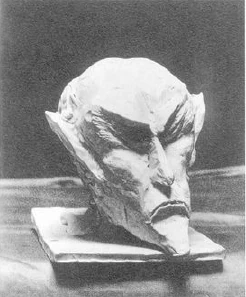
Next image (Fig. 101): The figure of Lucifer above, here the chest, wing-like. It is the case that one really has to immerse oneself in all of nature's creativity if one wants to give plastic form to something like this figure of Lucifer. Nothing can be symbolized, nothing can be allegorized, nothing can be thought and the thought put into earlier forms, but one must really delve into how nature creates, one must know the nature of the human rib cage, the lungs, one must know the organ of hearing, then the atrophied flight tools that the human being has in his two shoulder blades. All of this must be brought into context, because a person would look quite different if they were not intellectually developed, if the heart did not hypertrophy and overgrow everything: The heart, the hearing organs, wing-like organs, everything would be one. Those who do not merely accept the naturalistic, but also what is ideal, spiritual in the beings, will see in such art only that which reveals the secrets of the world and of existence in the Goethean sense. Up there you can see the hands of this asymmetrical rock creature.
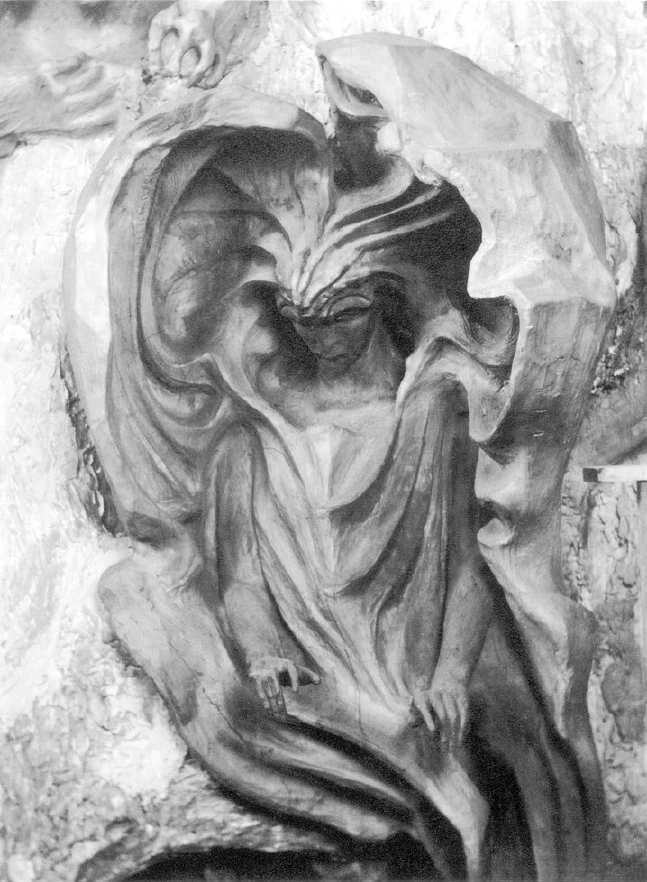
Next image (Fig. 103): Here you can see a building in the vicinity of the Goetheanum. It was originally built to carry out a kind of glass etching. Now it serves as a kind of office space, and eurythmy rehearsals and eurythmy lessons are also given there. In the wooden wall of the large domed room, there are glass windows between every two columns, and these glass windows are not made in the old glass window art, but in a special art, which I would call glass etching. Panes of glass of the same color are engraved with a diamond-tipped stylus that is clamped into an electric machine, and the artist actually works here as an etcher on glass, as he otherwise works as an etcher on a plate, only on a larger scale. So that you scratch out in the monochrome glass plate, thus working the motif in question into the light. This is how we got these glass windows, which have different glass colors, so that there is a harmonious effect. When you enter the building, you first come to one glass color, then to the other, to certain color harmonies. These glass windows had to be ground here; accordingly, this house was built, which, except for the gate and the staircase, is individually designed in every detail. Here we do not have the earlier castles that are otherwise present, but a special form of castle has been used (Fig. 105). So it is individually designed down to the last detail. Next picture (Fig. 104): The gate to this house just shown; below the concrete staircase.
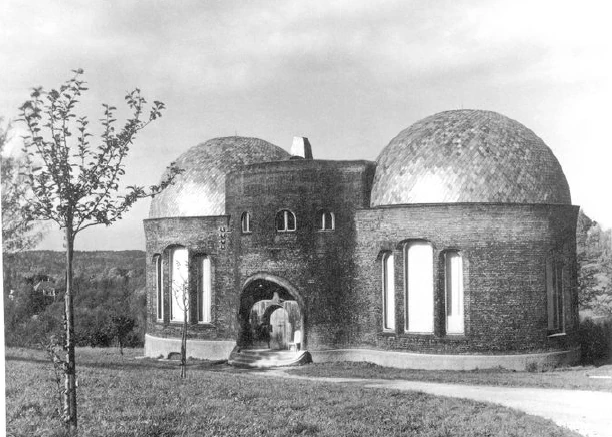
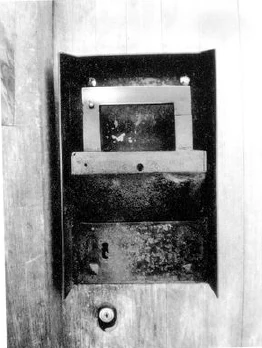

Next image (Fig. 110): Here you see one of these glass windows, which is executed in green. The motifs here are created out of green panes of the same color. The etching is actually only, I would say, a kind of score. This is then a work of art when it is in its place and the sun shines through. So the artist does not finish the work of art, but only a kind of score: when the sun shines through, this etching achieves what, together with the sunbeam shining through, actually creates the work of art. This again marks something that emerges from the whole building idea of Dornach and is physically expressed here.
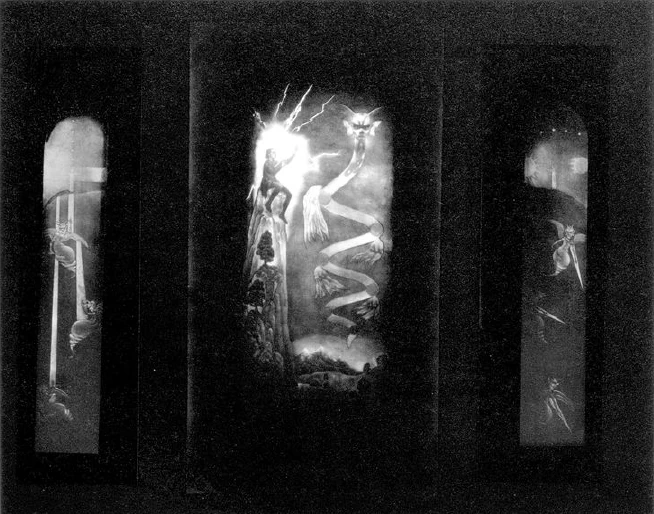
The Dornach building is built on a fundamentally different architectural idea from other buildings. The walls of the previous buildings are closing walls, artistically also conceived as closing walls. No wall in Dornach is conceived in this way; the walls in Dornach are designed in such a way that they are artistically transparent, so that one does not feel closed in when one is inside the building. All the walls, so to speak, open up through the artistic motifs to the whole great world, and one enters this building with the awareness that one is not in a building but in the world: the walls are transparent. And this is carried out in these glass windows right down to the physical: they are only a work of art when the sun shines through them. Only together with the sunbeam does what the artist has created become artistic.
Next picture (Fig. 113): Another window sample, taken from the same-colored glass pane. The fact that these windows are there means that the room is again illuminated with the harmoniously interwoven rays, and one can, especially when one enters the room in the morning hours, when it is full of sunshine, really feel something through the light effects in the interior, which cannot be called nebulous, but in the best sense inwardness, an impression, an image of the inwardness of the existence of the world and of human beings. For just as, for example, in Greek temple architecture there stands a house that can only be conceived as the house that no human being actually enters, at most the forecourt as a hall of sacrifice, but which is the dwelling place of the god, just as the Gothic building, regardless of whether it is a secular or a church building, is conceived as that which is not complete in itself, but which is complete when it has become a hall for assembly and the community is within it, the whole building idea of Dornach, as I have developed it here in its details, should work so that when a person enters this space, they are just as tempted to be in the space with other people who will look at what is presented and listen to what is sung, played or recited.
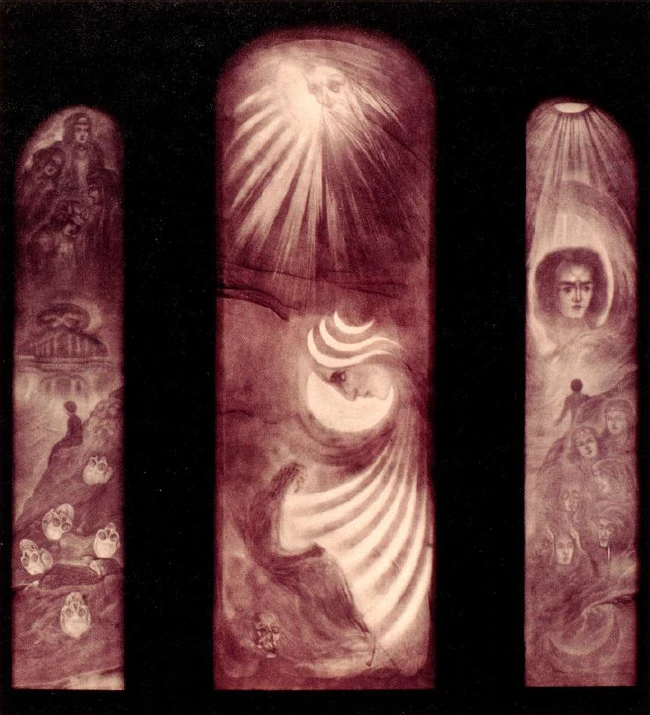
Man will be tempted, on the one hand, to feel sympathy with those who are gathered, but the question or the challenge that is as old as Western culture will also arise: know thyself! And he will sense something like an answer to this in the building around him: know thyself. The attempt has been made to express in the building forms, in an artistic and non-symbolic way, that which the human being can inwardly experience.
We have already experienced it: when, for example, an attempt was made to recite - to eurythmy or to recite to oneself - the space that I showed you as the organ room, when an attempt was made to recite into it, or when an attempt was made to speak of the intermediate space between the two dome spaces, the whole room took these things in as a matter of course. Every form is adapted to the word, which wants to unfold recitatively or in discussion and explanation. And music in particular spreads out in these plastic-musical formal elements, which the building idea of Dornach is meant to represent.
In conclusion, I would just like to say, my dear attendees: With these details, which I have tried to make clear to some extent through the pictures, I wanted to present to your souls what the building idea of Dornach should be: a thought that dissolves the mechanical, the geometric, into the organic, into that which itself presents the appearance of consciousness, so that this consciously appearing element willingly accepts that which arises from the depths of human consciousness.
However, this means that something has been created that differs from previous building practices and customs, but in the same way that spiritual science oriented towards anthroposophy also wants to place itself in the civilization of the present day: as something that feels related to the emerging forces of the rising sun, and at the same time wants to strongly oppose the terribly devastating forces of decline of our time. Thus, that which wants to live in the teaching of anthroposophy, the whole world view of anthroposophy, also wants to express itself through the building forms. What is to be heard in Dornach through the spoken word should also be seen in the forms. Therefore, no arbitrary architectural style was to be used, no arbitrary building constructed: it had to grow out of the same spiritual and intellectual background from which the words spoken in Dornach arise. The whole idea behind the building, the whole of the Dornach building, is not to be a temple building, but a building in which people come together to receive supersensible knowledge.
People say that just because one is too poor to find words for the new, one often says: that is a temple building. But the whole character contradicts the old temple character. It is entirely that which is adapted in every detail to what, as spiritual science in the anthroposophical sense, wants to step out into the world. And basically, every explanation is a kind of introduction to the language, to the world view, from which the artistic concept has emerged. I believe that artistically, the building expresses its own essence and content, even if it is still often perceived today as something that is not justified in terms of what is considered acceptable in terms of architectural style, forms and artistic language. Only someone who has already absorbed the impulse, the entire civilizing character of spiritual science, will understand that a new architectural idea had to emerge from this new world view. And as badly as contemporaries sometimes take it, something like this had to be presented, just as anthroposophical spiritual science had to be talked about.
And so, in the manner of a confession, today's discussion, which sought to point to the building of Dornach and to these thoughts, may simply conclude with the words: something was ventured that had not been done before as a building idea, but it had to be ventured. If something like this had not been ventured, had not been ventured at various points in time, there would be no progress in the development of humanity. For the sake of human progress, something must be ventured first. Even if the first attempt is perhaps beset with numerous errors – that is the very first thing that the person speaking here will admit – it must nevertheless be said: something like this must always be ventured again in the service of humanity. Therefore, my dear attendees, it has been ventured out there in Dornach, near Basel.
5. Der Baugedanke Des Goetheanum
Die anthroposophische Geisteswissenschaft hat in den letzten Jahren in Dornach bei Basel eine äußere Wirkungsstätte gefunden. Die Entstehung dieser Wirkungsstätte, die sich Goetheanum nennt, Freie Hochschule für Geisteswissenschaft, ergab sich aus dem Gang der Ausbreitung dieser anthroposophisch orientierten Geisteswissenschaft. Nachdem durch eine lange Reihe von Jahren von mir und anderen diese Geisteswissenschaft in den verschiedensten Staaten und Orten zunächst in ideeller Form verbreitet worden ist durch Vorträge oder Ähnliches, stellte sich etwa um das Jahr 1909, 1910 die innere Notwendigkeit heraus, durch andere Offenbarungs- und Mitteilungsmittel, als sie in den bloßen Gedanken und in den bloßen Worten liegen, dasjenige vor die Seelen der Mitmenschen heranzutragen, was mit dieser Geisteswissenschaft gemeint ist. Und so kam es denn dazu, dass aufgeführt wurden — zunächst in München - eine Reihe von Mysteriendramen, die von mir verfasst, in bildhafter, szenischer Form dasjenige geben sollten, wovon anthroposophische Geisteswissenschaft ihrer ganzen Wesenheit nach sprechen muss.
Man ist ja gewöhnt worden, durch den ganzen Bildungsgang der zivilisierten Welt in den letzten drei bis vier Jahrhunderten, Erkenntnis vorzugsweise zu suchen durch die äußere nliche Beobachtung und durch die Anwendung des menschlichen Intellektes auf diese äußere sinnliche Beobachtung, und im Grunde genommen sind alle unsere neueren Wissenschaften, insofern sie heute noch immer gangbar sind, durch Wirkungen der sinnlichen Beobachtungsergebnisse mit intellektuell Erarbeitetem zustande gekommen. Schließlich kommen auch die historischen Wissenschaften heute auf keine andere Weise zustande. Intellektualismus ist vorzugsweise dasjenige, zu dem die moderne Welt Vertrauen hat, wenn es sich um Erkenntnis handelt. Intellektualismus ist dasjenige, an das man sich dadurch immer mehr und mehr gewöhnt hat.
Und so ist man denn natürlich immer mehr und mehr zu dem Glauben gekommen, dass alles dasjenige, was an Erkenntnis-Ergebnissen vor die Welt tritt, restlos auch durch intellektuelle Mitteilungen sich offenbaren könne. Ja, es gibt wohl erkenntnistheoretische und sonstige wissenschaftliche Auseinandersetzungen, in denen scheinbar bewiesen wird, wie etwas nur dann gelten könne vor dem Erkenntnisgewissen der gegenwärtigen Menschen, wenn es sich intellektuell rechtfertigen lasse. Dasjenige, was sich nicht in logisch-ideelle intellektuelle Formen kleiden lässt, man lässt es nicht als Erkenntnis gelten. Geisteswissenschaft, die nun wirklich nicht haltmachen wollte vor dem, was man in der Naturwissenschaft mit Recht als naturwissenschaftliche Erkenntnisgrenzen geltend macht, die hinter diese Erkenntnisgrenzen dringen will, Geisteswissenschaft musste sich immer mehr und mehr darüber klar werden, dass die intellektuelle Art der Mitteilung nicht die Einzige sein könne. Denn man kann lange mit allen möglichen Scheingründen beweisen, dass man in intellektuelle Form alle Erkenntnisse hereinprägen müsse, wenn sie den Menschen befriedigen soll, man kann das lange
beweisen und mit Scheingründen belegen - wenn die Welt so beschaffen ist, dass sie nicht bloß in Begriffen, in Ideen ausdrückbar ist, dass sie - zum Beispiel namentlich wenn man die Gesetze der menschlichen Entwicklung kennen will - ausgedrückt werden muss durch Bilder, dann muss man auch zu etwas anderem vordringen als zu der Darstellung durch das Wort im theoretischen Vortrag, man muss zu anderen Darstellungen vorschreiten als zu der Darstellung in intellektuellen Formen.
Und so fühlte ich eben die Notwendigkeit, dasjenige, was das Voll-Lebendige ist, namentlich in der Menschheitsentwicklung, nicht allein bloß theoretisch auszudrücken durch das Wort, sondern auszudrücken durch das szenische Bild. Und so entstanden denn meine vier Mysteriendramen, die zunächst in den gewöhnlichen Theatern zur Darstellung kamen. Das war sozusagen der erste, durch die Sache der Geisteswissenschaft selbst, wie sie hier gemeint ist, gegebene Schritt nach einer erweiterten Darstellung desjenigen, was eigentlich sich offenbaren will durch diese anthroposophische Geisteswissenschaft.
Nicht bei mir selbst - das darf ich ruhig sagen -, sondern bei Freunden unserer Sache entstand nun im Laufe dieser Entwicklung, die eine äußere bühnenmäßige Darstellung notwendig machte, der Gedanke, der Wirksamkeit dieser Geisteswissenschaft eine eigene Stätte zu bereiten. Und nach mancherlei Versuchen, da oder dort diese Stätte zu begründen, landete man zuletzt am Dornacher Hügel in der Nähe von Basel, wo wir von unserem Freund Dr. Emil Grosheintz ein Grundstück zu diesem Zweck geschenkt bekamen, und wir konnten auf dem Dornacher Hügel diese Hochschule für Geisteswissenschaft aufrichten, die zugleich ein Darstellungshaus sein soll für die anderen Offenbarungsarten dessen, was durch diese Geisteswissenschaft zutage treten soll; diese Hochschule für Geisteswissenschaft, die wir heute «Goetheanum» nennen.
Nun, wäre irgendein Verein mit diesem oder jenem Programm darangegangen, durch die Verhältnisse veranlasst eine solche Umrahmung, ein solches Haus, eine Architektur aufzurichten: Was wäre geschehen? Man hätte sich an diesen oder jenen Baumeister gewandt; der hätte dann vielleicht, ohne sehr intensiv irgendetwas zu fühlen oder zu empfinden und zu erkennen von dem Inhalte unserer Geisteswissenschaft, im antiken oder gotischen oder im Renaissance- oder in irgendeinem anderen Stile einen Bau aufgeführt, und man würde in einem solchen Bau, der nun aus ganz anderen Kulturvoraussetzungen heraus erbaut worden wäre, tradiert haben dasjenige, was der Inhalt der Geisteswissenschaft auf den verschiedensten Gebieten ist. So hätte es ja wohl geschehen können bei vielen anderen Bestrebungen der Gegenwart und wäre ohne Zweifel geschehen. Bei dem, was anthroposophisch orientierte Geisteswissenschaft ist, konnte das nicht geschehen.
Als wir im vorigen Jahr unsere erste Kursusreihe über die verschiedensten Wissenschaften in der geisteswissenschaftlichen Hochschule zu Dornach eröffneten, da konnte ich davon sprechen, wie durch diese anthroposophisch orientierte Geisteswissenschaft nicht bloß dasjenige vor die Menschheit hintreten soll, was im engeren Sinne Wissenschaft ist, wie diese Geisteswissenschaft nicht nur aus den Errungenschaften der menschlichen Sinnesbeobachtungen, des menschlichen Intellektes schöpft, sondern wie sie aus dem Ganzen schöpft, aus dem vollen Menschentum, und wie sie aus den Quellen schöpft, aus denen auch hervorgeht Religion auf der einen Seite, Kunst auf der anderen Seite.
Nicht will diese Geisteswissenschaft etwa ausbilden eine abstrakt symbolische oder eine stroherne allegorische Kunst, die bloß das Didaktische in äußere Formen zwängt. Nein, das ist durchaus nicht der Fall, sondern dasjenige, was ins Wort gebracht wird durch diese Geisteswissenschaft, kann durch das Wort wirken, kann sich durch das Wort gestalten. Es kann gesprochen werden von geistigen Vorgängen, von geistigen Wesenheiten der übersinnlichen Welt, indem man zu Ideen und zu den Ausdrucksmitteln der Ideen, zu den Worten, seine Zuflucht nimmt. Aber dasjenige, was dahinter steht, was sich eben auf diese Weise offenbaren will, ist viel reicher als was ins Wort, in die Idee hineinkommen kann, drängt in die Form, in das Bild, wird von selbst zur Kunst, zur wirklichen Kunst, nicht zu einem allegorischen oder symbolischen Aussprechen. So ist es nicht gemeint, wenn von Dornacher Kunst die Rede ist.
Wenn von Dornacher Kunst die Rede ist, so wird zunächst verwiesen auf den ursprünglichen Quell dessen, woraus Menschendasein und Weltendasein heraussprudelt. Was man in diesem ursprünglichen Quell erlebt, wenn man auf die auch oftmals hier geschilderte Art den Zugang dazu gewinnt, das kann man in Worte kleiden, in Ideen formen, das kann man aber auch, ohne dass man diese Ideen allegorisch oder symbolisch ausdrückt, unmittelbar ausfließen lassen in Künstlerisches. Das, was im Künstlerischen oder auch - ich könnte es weiter ausführen, das ist heute nicht nötig - im Religiösen leben kann, das ist ein völlig gleicher Ausdruck dessen, was auch in ideeller Darstellung gegeben werden kann. Diese anthroposophisch orientierte Geisteswissenschaft ist also von vornherein so veranlagt, dass sie als eine Strömung aus einem Quell fließt, aus dem auch Kunst und Religion in ursprünglicher Art fließen können. Dasjenige, was wir in Dornach meinen, wenn wir von religiösen Empfindungen sprechen, ist nicht etwa bloß eine zur Religion gemachte Wissenschaft, sondern ist Ursprung elementarer religiöser Kraft, und das, was wir als Kunst meinen, ist eben auch wiederum ursprünglich elementarisch künstlerische Schöpfung.
Wenn daher manche Besucher des Goetheanum oder namentlich auch solche, die sich davon nur erzählen lassen, unseren Dornacher Bau verleumden und sagen, da finde man diese ‚oder jene allegorische, symbolische Darstellung, so ist das eben eine Verleumdung. In dem gesamten Dornacher Bau findet sich nicht ein einziges Symbolum. Alles dasjenige, was dargestellt wird, ist in die künstlerische Form übergeflossen, ist unmittelbar empfunden. Und im Grunde genommen fühle ich immer etwas wie die Darbietung eines bloßen Surrogates, wenn von mir vorausgesetzt wird, dass ich den Dornacher Bau durch Worte erkläre. Gewiss, wenn man abseits von Dornach spricht, so kann man Mitteilungen darüber machen, wie man über Kapitel der Kunstgeschichte zum Beispiel spricht. Aber wenn man in Dornach selber den Bau sieht, dann empfinde ich es immer eigentlich als etwas Surrogathaftes, wenn man ihn außerdem noch erklären soll. Es ist diese Erklärung eigentlich auch nur notwendig, um die besondere Art der Weltanschauungssprache an die Menschen heranzubringen, aus der aber herausgeflossen ist der Dornacher Bau geradeso wie, sagen wir, die Sixtinische Madonna herausgeflossen ist aus der christlichen Weltanschauung, ohne dass irgendetwas symbolisiert ist, sondern nur so, dass wirklich in dem Künstler empfindungsgemäß Ideenhaftes gelebt hat.
Hamerling, dem österreichischen Dichter, wurde auch der Vorwurf gemacht, nachdem er seinen «Ahasver» geschrieben hat, dass er Symbolik gebraucht habe. Er hat mit Recht dann seinen Kritikern erwidert: Was soll man denn eigentlich anders tun, wenn man den Nero recht lebendig darstellt, volllebendig als eine menschliche Wesenheit, als ihn als das Symbolum der Grausamkeit hinzustellen! Denn die Geschichte selber hat das Symbolum der Grausamkeit in Nero hingestellt, und es liegt nicht der Fehler daran, dass man den Eindruck des wahren, des realen Symbolums der Grausamkeit hat, wenn Nero lebendig hingestellt wird, sondern es könnte höchstens der künstlerische Mangel vorliegen, wenn man irgendeine stroherne Allegorie statt der lebendigen Wesenheit hinstellt. Wenn auch die Welt, die in Dornach dargestellt ist, die übersinnliche Welt ist, so ist sie die übersinnlich geschaute, die übersinnliche Realität, die dargestellt wird. Es ist nicht irgendetwas, was symbolisch oder allegorisch [die] Umsetzung von Begriffen anstreben will. Das ist dasjenige, was durchaus zugrunde liegt und was zugleich hindeutet darauf, warum nicht in beliebiger Weise ein Haus hingestellt werden konnte für diese anthroposophisch orientierte Geisteswissenschaft. Ein jeder Baustil wäre ihr etwas Äußerliches gewesen, denn sie ist eben nicht bloße Theorie, sie ist Leben auf allen Gebieten und konnte ihren Baustil selbst hervorbringen.
Gewiss, man kann nachträglich vielleicht eine historische Linie ziehen, indem man das Wesen der Architektur der Antike mit ihrem Lasten und Tragen charakterisiert, indem man dann übergeht zur Gotik und zeigt, wie da die Architektur herausgeht aus dem bloßen Lasten und Tragen, und wie das Strebewerk wieder durch den Spitzbogen und durch das Kreuzrippengewölbe frei gemacht ist von dem bloßen Lasten und Tragen, wie eine Art Übergang zum Lebendigen gefunden ist. In Dornach [wurde aber] der Versuch gemacht, dieses Lebendige so weit zu treiben, dass man wirklich das bloße Dynamische, Metrische, Symmetrische früherer Bauformen übergeführt hat in das Organische.
Ich weiß sehr wohl, wie viel man zunächst vom Gesichtspunkte der alten Baukunst schreiben kann gegen dieses Übergehenlassen der geometrischen, der metrischen, der symmetrischen Formen in organische Formen, in Formen, die sich sonst an den organischen Wesen finden. Aber es ist nichts irgendwelchen Organismen naturalistisch nachgebildet, sondern es ist nur der Versuch gemacht, sich einzuleben in das organisch schaffende Prinzip der Natur. So wie man sich einleben kann in das Lasten und Tragen, wenn man die Säulen bedeckt sein lässt von den Querbalken, wie man sich wieder einleben kann in die ganze Konfiguration der Gotik im Strebewerk, im Kreuzrippengewölbe und so weiter, so kann man sich auch einleben in jenes innerliche Formen, Formschaffen der Natur, das in dem Hervorbringen des Organischen vorhanden ist. Kann man sich da hineinfinden, dann gelangt man nicht zu einem naturalistischen Nachbilden dieser oder jener Flächenformen, die sich im Organischen finden, sondern man gelangt dazu, aus dem heraus, was man unmittelbar architektonisch dargestellt hat, Flächen zu finden, die sich in den ganzen Bau so hineingliedern, wie, sagen wir, die einzelne Fläche an einem Finger sich hineingliedert zum Beispiel in den ganzen menschlichen Organismus.
Das ist es, was daher beim Dornacher Bau zunächst als eine Grundempfindung erlangt werden kann, insofern das schon bei dem ersten Anhub dieses neuen Baustiles erreicht ist. Was angestrebt worden ist, ist eben das, was vielleicht so empfunden werden kann: Gegenüber der kleinsten Kleinheit ist der größte Formzusammenhang so gedacht, dass jedes an dem Orte, wo es sich befindet, so ist, wie es sein muss. Sie brauchen ja nur zum Beispiel an das Ohrläppchen an Ihrem eigenen Organismus zu denken. Dieses Ohrläppchen, es ist ein sehr kleines Organ. Wenn Sie den ganzen Organismus verstehen, so werden Sie sich sagen: Das Ohrläppchen könnte nicht anders sein, als es ist; das Ohrläppchen kann nicht kleine Zehe sein, nicht rechter Daumen sein, sondern im Organismus ist jedes an seinem Orte, und jedes an seinem Orte so, wie es aus diesem Organismus hervorgeht.
Das ist in Dornach versucht worden. Der ganze Bau, die ganze Architektur sind so, dass sie aus dem Ganzen heraus gedacht sind, und jedes Einzelne ist an seinem Orte ganz individuell so gestaltet, wie es an diesem Orte sein muss. Trotzdem man viel einwenden kann: Es ist eben einmal, wie gesagt, der Versuch gemacht worden, den Übergang vom bloßen geometrisch mechanischen Bauen zu dem Bauen in organischen Formen zu vollziehen. Man könnte, wie gesagt, diesen Baustil angliedern an andere Baustile, aber damit kommt man doch nicht eigentlich weiter. Insbesondere der Schaffende kommt damit nicht weiter. So etwas muss eben einfach aus dem Naiven, aus dem Elementaren heraus entstehen. Deshalb kann ich nur, wenn ich gefragt werde, wie die einzelne Form aus dem Ganzen heraus empfunden ist, die folgende Antwort geben. Ich kann nur sagen: Man betrachte zum Beispiel eine Nuss. Die Nuss hat eine Schale. Diese Nussschale, sie ist nach denselben Gesetzen um die Nuss herum gebildet, um den Nusskern, nach denen die Nuss selber, der Nusskern entstanden ist, und die Schale können Sie sich nicht anders denken, als sie ist, wenn einmal der Nusskern so ist, wie er ist.
Nun kennt man die Geisteswissenschaft. Man trägt die Geisteswissenschaft aus ihrem inneren Impulse heraus vor. Man gestaltet sie in Ideen, man bringt sie in Ideen zusammen. Man lebt also in dem ganzen innerlichen Sein dieser Geisteswissenschaft. Verzeihen Sie, es ist ein trivialer Vergleich, aber es ist eben ein Vergleich, der veranschaulicht, wie man aus dem Naiven heraus schaffen muss, wenn man so etwas schaffen will, wie es der Dornacher Bau ist: Man steht darinnen wie in dem Nusskern und hat darinnen die Gesetze in sich, nach denen man die Schale, den Bau, ausführen muss.
Ich habe früher oftmals noch einen anderen Vergleich gemacht. Sehen Sie, in Österreich nennt man eine besondere Art der Mehlspeise «Gugelhupf». Ich weiß nicht, ob der Ausdruck hier auch gebräuchlich ist. Und ich habe gesagt, man solle sich vorstellen, anthroposophische Geisteswissenschaft ist der Gugelhupf und der Dornacher Bau ist der Gugelhupf-Topf, in dem gebacken wird. Der Gugelhupf und der Topf, beide müssen durchaus zusammenstimmen. Das ist das Richtige, wenn beide zusammenstimmen, das heißt, wenn sie nach denselben Gesetzen sind wie Nuss und Nussschale.
Weil anthroposophische Geisteswissenschaft eben aus dem ganzen, aus dem vollen Menschentum heraus schafft, konnte sie nicht die Diskrepanz in sich haben, für ihren Bau einen beliebigen Baustil zu nehmen und in ihn hineinzusprechen. Sie ist eben mehr als bloße Theorie, sie ist Leben. Daher musste sie nicht nur den Kern liefern, sondern auch die Schale in den einzelnen Formen. Es musste gebaut werden nach denselben innerlichsten Gesetzen, nach denen gesprochen wird, nach denen Mysterien vorgeführt werden, nach denen jetzt die Eurythmie vorgeführt wird. Alles dasjenige, was man in Worten vorführt, was man eurythmisch aufgeführt sieht, was man in den Mysterienspielen aufgeführt sehen wird, was sonst vorgeführt wird, das muss so durch den Saal klingen und gesehen werden, dass die Wände mit ihren Formen, dass die Malereien, die da sind, wie selbstverständlich dazu Ja sagen; dass die Augen gewissermaßen sie aufnehmen wie etwas, woran sie unmittelbar teilhaben. Jede Säule soll in derselben Weise sprechen, wie der Mund spricht, indem er die anthroposophisch orientierte Geisteswissenschaft verkündet. Eben gerade weil sie zugleich Wissenschaft, Kunst und Religion ist, musste anthroposophisch orientierte Geisteswissenschaft, absehend von allen gebräuchlichen Baustilen, ihren eigenen Baustil hinstellen. Man kann diesen nun selbstverständlich in Grund und Boden hinein kritisieren; aber alles das, was einmal auftritt, tritt zunächst unvollkommen hervor, und ich darf Ihnen vielleicht die Versicherung geben, dass ich am genauesten alle Fehler kenne, und dass ich derjenige bin, der sagt: Sollte ich den Bau ein zweites Mal aufführen, würde er zwar aus derselben Gesinnung, aus denselben Gesetzen heraus sein, aber er würde durchaus in den meisten Einzelheiten und vielleicht sogar im Ganzen anders sein. Aber wenn irgendetwas in Angriff genommen werden muss, so muss es einmal in Angriff genommen werden, so gut man es gerade in diesem Zeitpunkt kann. Man lernt ja eigentlich, indem man so etwas aufführt, erst die eigentlichen Gesetze seines Wesens kennen. Das ist etwas, was nun einmal die Schicksalsgesetze des geistigen Lebens, des geistigen Fortschrittes sind, und gegen diese ist ja wohl auch bei der Aufrichtung des Dornacher Baus nicht verstoßen worden.
Nun erhebt sich der Bau auf dem Dornacher Hügel (Abb. 1). Empfunden mussten seine Grundformen werden zunächst, nicht wahr, sich heraushebend aus dem Dornacher Hügel. Daher ist der untere Teil ein Betonbau (Abb. 4). Ich versuchte aus diesem spröden Material des Betons heraus künstlerische Formen zu holen, und es haben doch manche empfunden, wie diese Formen sich anschließen an die Felsenformen, wie also die Natur mit einer gewissen Selbstverständlichkeit da übergeht in die Bauformen. Dann erhebt sich auf der horizontalen Terrasse, bis zu welcher der Betonbau geht, der Holzbau. Dieser Holzbau, der besteht aus zwei sich ineinanderfügenden Zylindern, die abgeschlossen sind von zwei nicht vollen Halbkugeln, die gewissermaßen ineinandergefügt sind im Kreis, sodass zwei Halbkugeln, zwei aufeinander folgende Halbkugeln wie ineinandergelegt die beiden Zylinderräume abschließen. Ein größerer Raum, der Zuschauerraum, ein kleinerer Raum derjenige, von dem aus Eurythmie aufgeführt wird, Mysterien gespielt werden und so weiter. Zwischen den beiden Räumen ist dann das Rednerpodium. Das ist zunächst das Hauptgebäude.


Nicht unerwähnt lassen darf ich natürlich, dass ja in den letzten Jahren mittlerweile sich zahlreiche Freunde insbesondere aus diesem oder jenem wissenschaftlichen Gebiete jetzt schon von fast allen wissenschaftlichen Gebieten her gefunden haben, die durchschaut und erkannt haben, wie Naturwissenschaft, Mathematik, Geschichte, Medizin, Jurisprudenz, Soziologie, wie die verschiedensten enschaften befruchtet werden können von anthroposophischer Geisteswissenschaft. Sodass sich anschließen muss an Dornach eben eine wirkliche Universitas, und für diese ist eigentlich das, wofür wir zunächst haben sorgen können, nichts weiter als ein großer Hörsaal, mit der Möglichkeit, eben auch noch in anderer Weise in diesen Hörsaal, der etwa für tausend Personen bestimmt ist, hineinzuwirken als durch das bloße Wort.
Dass der Bau in dieser Weise, ich möchte sagen, eine dualistische Form hat, aus zwei von Halbkugeln gekrönten Zylindern besteht, das kann doch herausgefühlt werden aus der ganzen Aufgabe, die sich Geisteswissenschaft, wie wir sie in Dornach meinen, stellen muss. Da liegt ja zugrunde dasjenige, was man innere menschliche Entwicklung nennt. Zu dieser anthroposophischen Geisteswissenschaft kommt man nicht dadurch, dass man nur die gewöhnliche alltägliche Urteilskraft verwendet - obwohl auf dieser natürlich durchaus voll gebaut wird -, dass man die gewöhnlichen Forscherregeln verwendet; sondern dadurch, dass
man in der Seele schlummernde Kräfte in der Art, wie es dargestellt ist in meinem Buche «Wie erlangt man Erkenntnisse der höheren Welten?», hervorholt und wirklich hinaufsteigt in diejenige Region, wo sich einem die übersinnlichen Kräfte und Wesenheiten des Daseins offenbaren. Dieses Sich-Offenbaren aus einer übersinnlichen Welt an die sinnliche, das sich da ausdrückt, indem die tausend Zuhörer oder Zuschauer dasitzen und auf der andern Seite eben dasjenige mitgeteilt wird, was Kunde von übersinnlichen Welten gibt, dieses Ganze, in Empfindung umgesetzt, drückt sich eben in dem Doppelkuppelbau zu Dornach aus. Es ist nicht in irgendeiner Weise symbolisch gemeint. Deshalb kann ich auch sagen: Natürlich könnte man diesen Gedanken auch anders ausdrücken, aber so hat sich mir eben der künstlerische Ausdruck dieses Grundgedankens dazumal, als es notwendig war, ergeben.
So sieht man gewissermaßen, indem man von der Umgebung herankommt, in der äußeren Form des aus dem Beton herauswachsenden Holzbaues, der ein Doppelkuppelbau ist, man sieht in der Konfiguration, in der Flächengestaltung dasjenige, was eigentlich mit anthroposophisch orientierter Geisteswissenschaft gemeint ist. Dass man versucht hat, wirklich nicht zu rechnen etwa mit abstrakten Begriffen, sondern mit der künstlerischen Empfindung, das mag Ihnen noch daraus hervorgehen, dass — in der Zeit, als das noch möglich war vor dem Kriege - mit allen möglichen Mühen norwegischer Schiefer zum Eindecken der beiden Kuppeln heruntergeholt worden ist. Als ich einmal auf einer Vortragsreise im Jahr 1913 zwischen Christiania und Bergen war, sah ich den wunderbaren Vossischen Schiefer. Und dieser Vossische Schiefer glänzt nun von den Doppelkuppeln im Sonnenschein, sodass man eigentlich das Gefühl hat: Dieser grünlich-gräuliche Sonnenglanz, der sich einem da reflektiert, der gehört in diese ganze Landschaft hinein. Mir erschien gerade in dieser Sorgfalt, die beobachtet worden ist, nun selbst den Sonnenglanz in der richtigen Weise in einer solchen Landschaft zur Geltung zu bringen, etwas, was zeigt, dass man Rechnung getragen hat, auch etwas Würdiges hinzustellen an diesem Ort, der ja als Ort, als Lokalität etwas Außerordentliches hat.
Ich werde mir nun erlauben, das, was entstanden ist als dieses Goetheanum in Dornach, Ihnen in einer Reihe von Lichtbildern vorzuführen. Sie sollen im Einzelnen zeigen, wie dasjenige, was ich nun ausgeführt habe, wie der Dornacher Baugedanke eigentlich sich verwirklicht hat. Es soll durchaus durch den Dornacher Baugedanken dasselbe in der äußeren Raumform im Bilde vor dem Beschauer dastehen, was vor dem Hörer sich ausbreitet durch das Wort, sodass, was man in Dornach hört, dasselbe ist wie dasjenige, was man in Dornach sieht. Aber weil es wirklich darbieten sollte eine Erneuerung aus dem geistigen Leben heraus, eine Erneuerung alles Wissenschaftlichen, brauchte es auch in gewissem Sinne eine neue Kunst.
Nun das erste Bild (Abb. 4): Sie sehen hier den Bau, die eine Kuppel ist hier etwas bedeckt, hier den Beton-Unterbau. Wenn man sich über einen Weg, der von Nordwesten her gegen das Westtor führt, nähert, hat man diesen Anblick. Dies ist also der Beton-Unterbau mit dem Eingang; hier geht man zunächst hinein. Weiter rückwärts in diesem Betonbau sind dann die Ablegeräume. Nachdem man abgelegt hat, geht man über die Treppe, die durch diesen Raum führt, links und rechts hinauf und kommt zunächst in einen Vorraum - in welchen man auch von der Terrasse aus durch das Haupttor in den Bau hineingeht - und von dort in den Zuschauerraum. Sie sehen hier, beginnend von dieser Terrasse ab nach oben, den Holzbau, der von nordischem Schiefer zugedeckt ist (Abb. 10). Sie sehen an dieser Form, die über dem Haupteingangstor im Westen ist, den Versuch, an dieser Stelle etwas hineinzugestalten, das eben wirklich wie eine organische Form herauswächst aus dem Ganzen des Baus. Es ist nicht irgendetwas, das in der organischen Welt sich findet, naturhaft nachgebildet, sondern es ist das organische Schaffen selbst zu erkunden gesucht. Es ist versucht, durch Hingabe an das organische Schaffen in der Natur die Möglichkeit zu haben, selbst solche organischen Formen zu gestalten und das Ganze ohne Verletzung der dynamischen Gesetze zu einer organischen Form zu gestalten. Ich bemerke ausdrücklich: ohne die dynamischen oder mechanischen Gesetze zu verletzen.

Derjenige, der namentlich die Innenarchitektur bei uns in Dornach studiert, wird überall sehen, dass, trotzdem Säulen, Pfeiler und so weiter organisch gestaltet sind, gerade in dieser organischen Gestaltung dasjenige liegt, was richtig trägt, richtig lastet, ohne dass es in der Dicke der Säulen, in der Schwere irgendeiner Belastung zum Ausdruck kommt. Das richtige Lasten und Tragen ist eben ohne das erreicht durch das organische Formen, sodass man gewissermaßen das Gefühl hat: Der Bau empfindet zu gleicher Zeit das Lasten und Tragen. Es ist also dieses Übergehen zum Scheine der Bewusstheit, wie es im Organischen ist, das, was an diesem Bau angestrebt werden musste aus Untergründen anthroposophisch-geisteswissenschaftlichen Wollens heraus. Also ohne irgendwie zu sündigen gegen die mechanischen, geometrischen, symmetrischen Gesetze der Baukunst sollte die Bauform ins Organische übergeführt werden.
Das nächste Bild (Abb. 5): Sie sehen hier von einem etwas weiteren Punkt aus und mehr von der Westfront aus den Betonbau unten; hier die Terrasse, dann den Haupteingang. Hier zeigt sich dasselbe Motiv. Die zweite Kuppel, die kleinere, die für den Bühnenraum ist, ist hier bedeckt; dagegen sieht man gewissermaßen das Anschließende. Da, wo sich die beiden Kuppelbauten aneinander anschließen, sind Querbauten links und rechts mit den Ankleideräumen für die Mitspielenden bei den Mysterienspielen oder bei eurythmischen Darstellungen, oder auch Büroräume und dergleichen. Das sind also Nebenbauten hier. Wir werden gleich im Grundriss sehen, wie sich diese Nebenbauten in den ganzen Baugedanken hineinschließen.

Das nächste Bild (Abb. 7): Hier sehen Sie den Bau von der Südwestseite: wiederum das Westtor, die große Kuppel, noch ein ganz winziges Stück von der kleinen Kuppel, nach Süden den südlichen Vorbau; hier die ganze Front zwischen Westen und Süden.

Das nächste Bild (Abb. 3): Hier sehen Sie von der andern Seite, von Nordosten aus, die beiden Kuppelräume, den Zuschauerraum, von vorn einen der Querbauten, hier den kleinen Kuppelraum und hier die Magazinräume, die sich an den kleinen Kuppelraum nach Osten hin anschließen; ferner die Terrasse, unten den Betonbau. Das ist der Vorbau, der dann zum Westtor führt, das Sie gerade eben gesehen haben.

Das nächste Bild (Abb. 2): Das ist nun der merkwürdige Bau, der ganz besonders stark angefochten wird. Diesen Anblick haben Sie, wenn man von der Nordostseite her an den Bau heranschaut: Man sieht dann dieses Heiz- und Beleuchtungshaus. Das ist nun auch so, dass man eben genötigt war, aus dem spröden Betonmaterial heraus etwas zu formen, und dass man aus künstlerischen Gesetzen heraus, aus künstlerischen Empfindungen sich sagte: Da ist mir alles dasjenige gegeben, was als Beleuchtungsmaschinerie, als Beheizungsmaschinerie notwendig ist: Das ist mir Nusskern, um den habe ich die Nussschale herumzubilden, für den Rauchabzug das Nötige zu bilden. Es ist schon, wenn ich mich trivial so ausdrücken darf, dieses Prinzip der Nussschalenbildung ganz durchgeführt. Und derjenige, der über so etwas schilt, der sollte bedenken, was da stehen würde, wenn nicht dieser Versuch gemacht worden wäre, der vielleicht heute noch unvollkommen gelungen ist. Hier würde nämlich ein roter Schornstein stehen! Einen Utilitätsbau hat man eben im Grunde so zu schaffen, dass man erstens das nötige Materialgefühl sich aneignet und dann durchaus aus der Bestimmung heraus die Umrahmung findet.

Das nächste Bild (Abb. 20): Hier gestatte ich mir, den Grundriss des Ganzen zu zeigen. Der Haupteingang von Westen her: Man kommt durch einige Vorräume in den Zuschauerraum herein. Dieser Zuschauerraum umfasst Stühle für neunhundert bis tausend Zuhörer beziehungsweise Zuschauer. Hier sehen Sie einen Umgang, der nach innen abgeschlossen ist durch sieben Säulen auf jeder Seite. Symmetrisch ist hier nur einmal [etwas] angeordnet: nämlich im Verhältnis zu der Westostachse. Das ist die einzige Symmetrieachse. Nur in Bezug auf diese Symmetrieachse, die Ostwestachse, sind die Motive des Baues symmetrisch gestaltet; sonst findet sich keine Wiederholung. Daher sind die Säulen mit Kapitell- und Sockelmotiven versehen, die nicht einander gleich sind, sondern die in fortschreitender Entwicklung sind. Ich werde das später im Einzelnen zeigen. Wenn Sie also eine erste Säule haben links und rechts, eine zweite Säule links und rechts, so ist allerdings Kapitell und Sockel immer von der linken Seite betrachtet gleich dem der rechten Säule, aber die folgenden Säulen weisen immer andere Kapitelle, andere Sockel und darüber andere Architravmotive auf (Abb. 33-54).

Das ist durchaus so, dass es sich als eine Notwendigkeit ergeben hat aus dem organischen Bauen heraus. Und zwar beruht das auf einer künstlerischen Ausgestaltung des Goethe’schen Metamorphosenprinzips. Goethe hat ja diese Metamorphosenlehre - die meiner festen Überzeugung nach noch eine große Rolle spielen wird in der Wissenschaft von dem Lebendigen in genialischer Weise ausgebildet. Wer heute noch sein einfach geschriebenes Büchelchen «Versuch, die Metamorphose der Pflanze zu erklären» von 1790 liest, hat vor sich eine grandiose naturwissenschaftliche Abhandlung, die eben einfach nach den heutigen Vorurteilen noch nicht genügend gewürdigt werden kann. Wenn man einfach es ausdrücken will, muss man sagen: Goethe sieht die Pflanze als ein kompliziertes Blatt. Er beginnt nun von dem untersten Blatte an, das am nächsten dem Boden ist, verfolgt die Blätter nach oben bis zu den Herzblättern, die ganz anders geformt sind als die Laubblätter, dann die Blumenblätter, die sogar ganz anders gefärbt sind, dann wiederum die ganz anders geformten Staubgefäße und Stempel. Da sagt Goethe: Alles dasjenige, was so in scheinbar verschiedener Metamorphose in den Blättern der Pflanze erscheint, ist so, dass es sich zurückführen lässt auf ein ideell Gleiches und nur für den äußeren Sinnenschein in verschiedenen Metamorphosen auftritt. Im Grunde genommen wiederholt das Pflanzenblatt immer dieselbe Grundform; nur in der äußeren sinnlichen Anschauung ist das ideell Gleiche verschieden ausgestaltet, metamorphosiert.
Dieses Metamorphosieren bildet das Grundprinzip in der Gestaltung alles Lebendigen. Man kann das nun auch ins künstlerische Formen und Schaffen heraufheben, und dann kann man das Folgende machen: Man gestaltet zunächst das einfachste Kapitell oder den einfachsten Sockel aus für die erste Säule, die man hier hat, und dann übergibt man sich gewissermaßen den schaffenden Kräften der Natur, die man zuerst zu erlauschen versucht hat - nicht mit abstraktem Denken, sondern mit innerlicher Empfindung, die mit Willensimpuls [einen] Anteil an dem Schaffen der Natur erlauscht hat. Und dann versucht man, aus dem einfachen Motiv der ersten Säule ein etwas komplizierteres der zweiten Säule hervorzubringen, wie das etwas höher stehende Blatt an der Pflanze komplizierter ist als das vorhergehende, aber eine Metamorphose darstellt. Sodass also tatsächlich alle diese sieben Säulenkapitelle aus einander hervorgeholt sind, metamorphosisch auseinander hervorwachsen, wie die Formen der Blätter, die aufeinander sich bilden im Werden der Pflanze, metamorphosisch sich bilden. Es ist dadurch ein wirkliches Nachschaffen dem organischen Naturschaffen in diesen nicht einfach dasselbe Motiv wiederholenden Kapitellen, sondern es sind die Kapitelle in fortdauerndem Wachstum, vom ersten bis zum siebenten.Nun kommen natürlich die Leute, sehen da sieben Säulen - tiefe Mystik! Ja es finden sich durchaus Mitglieder der Anthroposophischen Gesellschaft, die in allerlei dunklen geheimnisvollen Andeutungen reden von der tiefen Mystik dieser sieben Säulen und so weiter. Es ist aber gar nichts darinnen als das künstlerische Empfinden. Ist man nämlich bei der siebenten Säule angekommen, so steht dieses Motiv der siebenten Säule dem der ersten Säule gerade so gegenüber - wenn man wirklich so schafft, wie die Natur geschaffen hat -, wie die Septime der Prim gegenübersteht. Und wie man in der Oktave das erste Motiv, die Prim wiederholt hat, so hätte man das erste Motiv zu wiederholen, wenn man zum achten übergehen würde.
Hier sehen Sie die Grenze zwischen der großen und kleinen Kuppel; da steht das Rednerpult, das versenkbar ist, weil es entfernt werden muss, wenn gespielt wird. Hier wiederum zwölf Säulen im Umkreise, hier die Grenze des kleinen Kuppelraumes, hier die beiden Querbauten für Ankleideräume und so weiter.
Das nächste Bild (Abb. 21): Hier habe ich einen Durchschnitt durch die Mitte geführt. Vom Westen kommt man herein durch die Vorräume. Hier ist der Bühnenraum, von hier aus der Zuschauerraum ansteigend, die Bankreihen, wiederum die sieben Säulen, hier durch eine besondere schwierige mechanische Zusammengliederung die große Kuppel mit der kleinen zusammengeschlossen. Hier sind die Magazinräume, der Betonunterbau, die Garderoberäume zum Ablegen. Hier geht man hinein, und hier sind dann die Treppen; hier kommt man herauf und da ist dann das Haupttor, durch das man eintritt.

Das nächste Bild (Abb. 22): Hier habe ich mir erlaubt, Ihnen mein ursprüngliches Modell durchschnitten vorzulegen. Der ganze Bau ist ja ursprünglich von mir im Jahr 1913 modelliert worden. Sie sehen hier zunächst den Zuschauerraum mit seinen sieben Säulen, die Vorräume, hier nur angedeutet das Innere der großen Kuppel, das dann ausgemalt worden ist; hier im kleinen Kuppelraum überall die Kapitelle - ich werde sie gleich im Einzelnen zeigen —, hier die Architravmotive darüber; hier die Sockelmotive, immer eins aus dem andern metamorphosisch hervorgehend. Es ist also ‘nur, ‘wie gesagt, eine Symmetrielinie, die Mittelachse des Baues. Sonst sind keine Wiederholungen zu finden, außer dem, was links und rechts gelegen ist.

Das nächste Bild (Abb. 10): Von der Terrasse aus gesehen noch einmal der Anblick des Westtores, des Haupteingangstores, mit zwei Flügelbauten, die notwendig sind [Lücke im Stenogramm].

Das nächste Bild (Abb. 12): Da ist ein solcher Flügelbau, der nördliche [von Nordosten her gesehen]. Hier steht dann auch das Haus von Dr. Großheintz, ein ganzer Betonbau mit etwa 15 Räumen, ein Familienhaus, wo ich versuchte, aus dem Betonmaterial heraus mit dem Einleben in dieses Betonmaterial ein Wohnhaus herzustellen. Das ist in der Nähe des Goetheanum für denjenigen erbaut, der uns den Grund und Boden geschenkt hat. Sie sehen hier, wie versucht ist, das Motiv zu metamorphosieren. Alles, was an diesem Bau ist, geht so wie ein Pflanzenblatt aus dem andern, sozusagen in seiner Form aus der andern Form hervor: Es ist durchaus in künstlerischem Sinne das Wirken der Metamorphose.

Nächstes Bild (Abb. 14): Hier ist einer der Seitentrakte, der Südtrakt. Sie sehen hier, wie das Motiv, das über dem Westeingang ist, in ganz anderer Form auftritt. Es ist der Idee nach dasselbe, der äußeren Form nach ganz anders. Das ist gerade so, wie, sagen wir, das gefärbte Blumenblatt der Idee nach dasselbe ist wie das unterste grüne Pflanzenblatt, und doch wiederum in äußerer Metamorphose etwas ganz anderes. So kann man in der Tat, indem man sich — aber empfindungsgemäß verstehend, nicht abstrakt gedanklich verstehend - in das Metamorphosische hineinlebt, hineinfindet, indem man sich an dasselbe hingibt, diesen organischen Baugedanken empfinden. Das sollte eigentlich nicht erklärt werden, sondern es sollte alles durch den Anblick selbst gegeben sein.

Wenn einmal der Bau fertig ist, werden diejenigen, die bekannt sind mit dem, was anthroposophische Gesinnung, anthroposophisches Fühlen ist, den Bau durchaus nicht als symbolisch empfinden, sondern als etwas, was aus dieser gesamten Gesinnung herausfließt. Natürlich wird man sagen, es müsste aus dem «allgemein Menschlichen» herausfließen; aber dieses allgemein Menschliche, das ist ja nur ein Nebel- und Phantasiegebilde, ein Phantastisches. Das Menschliche ist immer das Konkrete. Derjenige, der niemals etwas vom Christentum gehört hat, versteht natürlich auch nicht die Sixtinische Madonna. Derjenige, der kein christliches Empfinden hat, würde niemals in St. Maria delle Grazie das Heilige Abendmahl in Mailand verstehen. Es ist durchaus so, dass man sich aus der Sprache heraus hineinleben kann in dasjenige, was gegeben wird; aber abgesehen davon ist an dem ganzen Bau nichts Symbolisches, alle Formen sind metamorphosisch voneinander verschieden.
Nächstes Bild (Abb. 11): Hier sehen Sie einen solchen Seiten-Querbau, ganz von vorne angesehen, also hier von der Südseite. Hier oben in wesentlich verwandelter Metamorphose das Motiv, das auch über dem Westeingang ist. Alle diese Motive sind in verschiedenen Metamorphosen, sodass der ganze Baugedanke organisch durchgeführt ist. Ebenso würden Sie, wenn Sie die Säulen studieren würden, eine Grundform finden, und diese immer metamorphosisch gestaltet, wie schließlich beim Menschen die Schädelknochen metamorphosische Umgestaltung der Rückenmarksknochen sind, wie alles im Organismus bis in das Einzelnste hinein metamorphosische Umgestaltungen sind.

Der obere Teil (Abb. 14) des südlichen Querbaues für sich gesehen; dieses Motiv, das eben etwas kleiner da war, jetzt etwas vergrößert.
Nächstes Bild (Abb. 23): Sie sehen hier etwas von der Treppe, ein Stück des Treppenhauses. Man kommt etwa hier herein, würde durch den Haupteingang unten in den Betonbau kommen, geht über diese Treppe hinauf. Hier ist das Treppengeländer und hier ein Pfeiler zu sehen. An diesem Pfeiler sehen Sie, wie versucht ist, in organischer Form zu gestalten den tragenden Pfeiler, wie versucht ist, dem Pfeiler diejenige Form zu geben, die er haben muss nach dem entgegengesetzten Ausgang zu, weil da wenig zu tragen ist; diejenige Form, die er haben muss da, wo er sich aufstemmt, wo die ganze Schwere des Treppenbaues liegt. Natürlich kann man so etwas bloß geometrisch bilden. Aber es sollte eben einmal hier der Versuch gemacht werden, das Ganze wie beseelt zu bilden, sodass gewissermaßen der Schein der Bewusstheit des Tragens und Lastens hier drinnen liegt; bei jeder Kurve alles genau intuitiv abgemessen für die Stelle des Baues, an der sie sich befindet.

Besonders wenn Sie sich dieses Motiv hier ansehen (Abb. 24): Es sind drei aufeinanderstehende halbzirkelförmige Kanäle. Sie mögen es glauben oder nicht, aber es ist wahr: Wenn da jemand hinaufgeht und in den Zuschauerraum hineinkommt, so muss er eine gewisse Empfindung haben. Ich sagte mir, derjenige, der da hinaufgehe, müsse die Empfindung haben: Da drinnen, da werde ich mit meiner Seele geborgen sein, da ist Seelenruhe zum Aufnehmen der höchsten Wahrheiten, die der Mensch zunächst erstreben kann. Deshalb ergab sich mir aus der Empfindung heraus die Ausgestaltung dieser drei halbkreisförmigen Kanäle in den drei aufeinander senkrecht stehenden Raumrichtungen. Geht man nun über diese Treppe hinauf, so kann man dieses Gefühl der Beruhigung bekommen. Es ist nicht nachgebildet - das ist es eben nicht -, aber erst nachträglich erinnerte ich mich, dass die drei halbzirkelförmigen Kanäle im Ohr ja auch in diesen drei aufeinanderstehenden Richtungen stehen. Wenn sie verletzt werden, fällt der Mensch in Ohnmacht: Sie hängen also zusammen mit dem Gleichgewichtsgesetze. Es ist nicht aus naturalistischer Nachahmungssucht heraus entstanden, sondern aus demselben heraus, das nachempfunden ist demjenigen, nach welchem die Kanäle im Ohr angeordnet sind.

Hier kommt man von der Westseite herein, geht über die Treppe hinauf, hier die drei aufeinander senkrecht stehenden halbzirkelförmigen Kanäle, und hier noch einmal diese Pfeiler. Natürlich ist es ja nun schon einmal so im Leben - ich habe es oftmals erfahren -, wenn irgendwo die Leute einer Stadt einen Schauspieler oder eine Schauspielerin in bestimmten Rollen gesehen haben, und es ist nachträglich eine andere oder ein anderer gekommen, die gut, besser oder interessanter oder anders sein konnten: Man beurteilt sie nach den früheren. Machten sie alles gerade so wie die früheren, waren sie gut, machten sie es anders, waren sie schlecht, sie mochten an sich noch so gut sein. Und so beurteilen die Menschen natürlich auch so etwas nach dem, was sie gewöhnt sind, und wissen nicht, dass, wenn so etwas hingestellt wird, man wirklich auch versucht, an seinem Orte den Schein des Tragens nach den verschiedenen Seiten hin verschieden tragend herauszubringen, und dass dies herausgeholt ist aus der ganzen Organik des Baues. Die einen fanden es dünn, nannten es rachitisch, die anderen fanden, dass es einem Elefantenfuß ähnlich sehe, konnten es aber auch wieder nicht Elefantenfuß nennen, und so kam einer darauf, so recht töricht wie möglich es aus seiner eigenen Empfindung heraus einen «rachitischen Elefantenfuß» zu nennen. Das ist ja dasjenige, was heute so vielfach auftritt, wenn irgend der Versuch gemacht wird, aus dem Elementaren heraus etwas Neues zu holen.

Nächstes Bild (Abb. 27): Ist man nun über die Treppe heraufgegangen, so kommt man hier in den Vorraum, bevor man in den großen Kuppelraum hineingeht. Sie sehen hier nun schon den Holzbau beginnend. In dieser Höhe würde dann die Betonterrasse sein, darunter der Betonbau. Sie sehen an dieser Säule, wie das Kapitell wiederum mit allen seinen Kurven genau dem Ort angepasst ist, aber nicht bloß schematisch räumlich, sondern dynamisch angepasst ist. Dem Ausgang zu muss ein anderer Ausdruck des Tragens, dem Eingang zu wieder ein anderer Ausdruck des Tragens in den Kurven sein als gegenüber dem Bau, wo wiederum entgegengestemmt werden muss. Daher mussten auch alle diese Holzformen, Säulenkapitelle, Architrave und so weiter durch jahrelange Arbeit unserer Freunde von der Anthroposophischen Gesellschaft gemacht werden. Das alles ist ja Handarbeit, einschließlich hier zum Beispiel der Decke, die nun auch nicht irgendeine schematische Form hat, sondern nach allen Seiten hin in ihren Kurven, in ihren Flächen individuell ausgestaltet ist, nach der einen Raumrichtung anders [aus]gehöhlt ist als nach der anderen Raumrichtung. Und das alles nach dem Gesetze, wie etwa das Ohr nach vorn anders gehöhlt ist, als es nach hinten [aus]gehöhlt ist, und so weiter.

Nächstes Bild (Abb. 30): Nun sind wir hineingegangen und stehen in dem Raum, der der Zuschauerraum ist. Drehen wir uns um und schauen nach rückwärts, so sehen wir hier den Orgelraum, den Sie noch auf anderen Bildern genauer beurteilen können. Aber hier haben Sie nur das Modell, nicht so, wie es jetzt im Bau zu sehen ist, wo noch manches ergänzt ist. Es ist von mir versucht, diesen Orgeleinbau nun auch so zu machen, dass man nicht das Gefühl hat, es sei etwas hineingebaut in die übrige Räumlichkeit, sondern es ist an diesem Orte förmlich herausgewachsen aus dem Ganzen dasjenige, was sich hier als Orgelgehäuse und als Orgel selber darbietet. Daher ist auch die Architektur und Plastik angepasst an die Linien, die entstehen durch das Übrige, also die Orgelpfeifen und so weiter.

Nächstes Bild (Abb. 28): Sie sind gewissermaßen jetzt im Zuschauerraum, sehen vom Zuschauerraum auf die Säulen hin. Hier ist das Orgelmotiv, hier sind die zwei ersten Säulen mit ihren Kapitellen. Wir kommen dann zu den veränderten, metamorphosierten Kapitellen der zweiten, dritten, vierten Säule und so weiter - ich werde das gleich im Einzelnen zeigen darüber immer die Architravmotive und unten die Sockelmotive. Nächstes Bild (Abb. 29): Die Bilder sind zu verschiedenen Zeiten aufgenommen. Der Bau hat jetzt schon seit 1913 gedauert, wo der Grundstein gelegt worden ist, und die Bilder zeigen ihn in den verschiedensten Stadien. Hier wiederum, wenn man sich im Zuschauerraum umdreht und nach dem Westen sieht, das obere, das Orgelmotiv; die erste, zweite Säule mit Kapitellen links und rechts, die Kapitelle und die darüber liegenden Architrave durchaus einfach gestaltet. Ich werde nun im Folgenden immer eine Säule und die folgende zeigen, und dann jede Säule mit dem Säulenkapitell für sich, sodass Sie sehen, wie immer das folgende Säulenkapitell aus dem vorhergehenden metamorphosisch hervorgeht. Dadurch wird hier ganz besonders darauf aufmerksam gemacht, dass im Grunde genommen die einzelne Säule für sich gar nicht beurteilt werden kann, sondern nur die ganze Folge der Säulen in ihrer aufeinanderfolgenden Form beurteilt werden kann.

Nächstes Bild (Abb. 34): Hier sehen Sie also die erste Säule für sich, einfach von unten nach oben in den Formen, einfach von oben nach unten. Sie sehen ein denkbar einfaches Motiv.

Nächstes Bild (Abb. 35): Hier sehen Sie das erste Motiv, das erste Kapitell mit dem darüber liegenden Architrav; hier das zweite, aus dem ersten organisch hervorgehend. Das Motiv, das von oben nach unten geht, wächst; im Wachsen metamorphosiert es sich, ebenso das Motiv von unten nach oben. Man muss gewissermaßen sich hineinversetzt empfinden in die Kräfte, die tätig sind, wenn ein oberes Pflanzenblatt in seiner Form entsteht, metamorphosiert gegenüber dem unteren; so wächst auch dieses erste einfache Pflanzenmotiv zu einem mehr komplizierteren. Darauf kommt es an, dass man die ganze Folge der Motive nimmt, denn immer gehört das eine mit dem andern zusammen; überhaupt gehören alle sieben zusammen, bilden ein Ganzes.

Nächstes Bild (Abb. 36): Hier haben Sie die zweite Säule für sich. Es ist also überall so, dass das nächste Motiv aus dem vorhergehenden metamorphosisch hervorgeht. Jetzt werde ich die zweite und dritte Säule zeigen.

Nächstes Bild (Abb. 37): Die zweite und dritte Säule, wiederum komplizierter das dritte Kapitellmotiv mit dem Architravmotiv darüber, sodass man im Empfinden diese komplizierte Form wirklich herausbekommt, wenn man eben nicht sie symbolisch erklären will oder mit irgendwelchen intellektuellen Dingen an sie herankommt, sondern mit der Empfindung. Dann wird man schauen das Hervorgehen des einen aus dem andern.

Nächstes Bild (Abb. 38): Die dritte Säule für sich.

Nächstes Bild (Abb. 39): Die dritte und vierte Säule, das heißt die Kapitelle davon mit dem Architravmotiv. Hier könnte man glauben, dass in diesem Architravmotiv gesucht worden ist, eine Art Merkurstab zu bilden. Aber gesucht wurde es nicht, sondern es ist einfach empfunden, wie diese sich treffenden Formen, wenn sie weiterwachsen, sich weiter komplizieren, wie sie da werden, und dann ergibt die Empfindung dieses merkurstabartige Motiv wie von selbst. Ebenso, wie wenn dies weiterwächst: Von unten nach oben vereinfachen sich die Dinge, von oben nach unten komplizieren sie sich; dann entsteht diese Form, die ich jetzt wieder für sich zeigen werde.

Nächstes Bild (Abb. 40): Die vierte Säule.

Nächstes Bild (Abb. 41): Die vierte und fünfte Säule. Da geht aus diesem, wenn man sich’s weiter nach unten wachsend denkt, diese Form hervor, wird jetzt wiederum einfacher; und das von unten nach oben, das sprosst, möchte ich sagen, in reicherer Form nach oben. Das ist das Merkwürdige! Man glaubt, wenn man an Entwicklung denkt, aus einer gewissen falschen Vorstellung der Entwicklung, die sich allmählich gebildet hat: die Entwicklung gehe so vor sich, dass man zuerst ein Einfaches hat, dann ein Komplizierteres und dann ein immer mehr Komplizierteres, und das Vollkommenste sei das Allerkomplizierteste. Wenn man sich nun recht in die Entwicklungsimpulse hineinversetzt mit der künstlerischen Empfindung, so sieht man, dass das gar nicht so ist; dass man allerdings zuerst von dem Einfachen immer zu dem Komplizierteren vorrücken muss; dann aber kommt man in der Mitte der Entwicklung an das Komplizierteste, und dann wird es, indem es dem Vollkommeneren zugeht, wiederum einfacher.
Das war, meine sehr verehrten Anwesenden, während ich die Modelle ausgearbeitet habe zu diesen Sachen, für mich eine außerordentlich große Überraschung. Ich musste vom Einfachen zum Komplizierten übergehen - Sie sehen, wir sind hier bei der vierten und fünften Säule, also ungefähr in der Mitte der sieben Säulenformen - und ich musste in der Mitte das Komplizierteste haben und dann wiederum zu dem Einfacheren übergehen. Und gehe ich zurück, wie die Natur selber schafft, so finde ich auch das menschliche Auge, aber das menschliche Auge, obwohl es das Vollkommenste ist, ist nicht das komplizierteste. Wir haben bei gewissen niederen Tierformen im Auge zum Beispiel den Fächer, den Schwertfortsatz. Das Auge gewisser niederer Tierformen ist in gewisser Beziehung komplizierter als das vollkommene des Menschen. Auch in der Natur geht es nicht so vor sich, dass man vom Einfacheren zum Komplizierteren und dann weiter zum Kompliziertesten kommt, sondern indem man die Dinge weiter betrachtet, kommt man wieder zu dem Einfacheren. Das Vollkommenere ist wiederum einfacher. Und das stellt sich als eine künstlerische Notwendigkeit bei einem solchen Schaffen auch wieder heraus.
Nächstes Bild (Abb. 42): Die fünfte Säule für sich.

Nächstes Bild (Abb. 43): Jetzt die fünfte und sechste Säule. Sie sehen, hier ist das Säulenkapitell bei der fünften verhältnismäßig noch kompliziert; wächst es weiter, so wird es wieder einfacher: sodass also diese sechste Säule, obwohl sie vollkommener in ihrer Gestaltung, edler ist, wieder einfacher ist. Ebenso das Architravmotiv.

Nächstes Bild (Abb. 44): Einzeln für sich diese sechste Säule.

Nächstes Bild (Abb. 45): Sechste und siebente Säule, wesentlich wiederum vereinfacht. Nächstes Bild (Abb. 46): Die siebente Säule für sich, wiederum vereinfacht.

Nächstes Bild (Abb. 47): Dieses ist die siebente Säule, das Architravmotiv, hier ist der Spalt zwischen dem großen und dem kleinen Kuppelraum; hier ist der Vorhang drinnen. Dann die erste Säule des kleinen Kuppelraumes, und hier kommen wir in den kleinen Kuppelraum hinein.

Nun sind wir die Säulenordnungen des großen Kuppelraumes durchgegangen. Ich werde Ihnen nun auch noch aufeinanderfolgend die Sockelfiguren zeigen, die ebenso metamorphosisch organisch auseinander hervorgewachsen sind. Ich werde sie schnell aufeinander folgen lassen.
Nächstes Bild (Abb. 48): Hier zeige ich aufeinanderfolgend die Sockelfiguren. Erster Sockel.

Nächstes Bild (Abb. 49): Jedes geht immer metamorphosisch hervor aus dem andren: Zweiter Sockel.

Nächstes Bild (Abb. 50): Wenn Sie sich das geändert nun denken, kommt dieses heraus: Dritter Sockel.

Nächstes Bild (Abb. 51): Vierter Sockel, wieder komplizierter. Und nun beginnen mit den Sockelfiguren die Vereinfachungen, indem man zu dem Vollkommenen kommt.

Nächstes Bild (Abb. 52): Fünfter Sockel. Nächstes Bild (Abb. 53): Sechster Sockel. Nächstes Bild (Abb. 54): Diese siebente Sockelfigur ist verhältnismäßig wieder sehr einfach.



Nächstes Bild (Abb. 55): Nun, hier sehen Sie aus dem Zuschauerraum in den kleinen Kuppelraum hinein. Man sieht noch die letzte Säule des Zuschauerraums, dann Säulen und Architrave des kleinen Kuppelraums. Das ist der Abschluss des großen Kuppelraums, hier die Mitte des kleinen Kuppelraums. Hier ist eine Art Architrav ausgestaltet zwischen den zwei mittleren Säulen des kleinen Kuppelraumes, [darüber aber] nicht irgendeine symbolische Figur. Wenn Sie darinnen ein Pentagramm sehen wollen, so können Sie es in jeder fünfblättrigen Blume sehen. Wir haben [darunter] synthetisch alle Linien und Kurven zusammengefasst, die an den einzelnen Säulen verteilt sind. Oben ist dann die kleine Kuppel ausgemalt. Ich werde über dieses Ausmalen noch zu sprechen haben.

Das nächste Bild (Abb. 56): Einzelne Säulen des kleinen Kuppelraums. Hier der Spalt [für den Vorhang]. Es ist, wenn man hineingeht von Westen nach Osten, hier zur linken Hand gesehen. Hier ist der Architrav des kleinen Kuppelraums. Hier sind, wie Sie sehen, wiederum nicht etwa die Kapitelle des großen Kuppelraums wiederholt, sie entsprechen dem ganzen Baugedanken. Da der kleine Kuppelraum eben kleiner ist und jedes Organ, das eben im organischen Zusammenhang kleiner ist, auch andre Formen hat, so ist das durchaus auch festgehalten hier in der Formung des Ganzen.

Das nächste Bild (Abb. 64): Hier ist wiederum der Einblick in den kleinen Kuppelraum, die zwei letzten Säulen des großen Kuppelraums; dasselbe Motiv, das Sie gerade in anderem Aspekt gesehen haben, und hier die kleine Kuppel. Man kann natürlich hier von den Malereien nichts [Einzelnes] sehen, es konnte nur die Situation hier angedeutet werden. Die Sockel der kleinen Säulen sind umgestaltet zu Sitzen.

Das nächste Bild (Abb. 67): Hier würden die Säulenordnungen weitergehen links und rechts; das ist in der Mitte im Osten unmittelbar unter dem kleinen Kuppelraum, wo in den verschiedensten Formen synthetisch alle Linien, alle Kurven zusammengefasst sind, die sich sonst finden. Es ist dies eine Art Architrav, Mittelarchitrav; darunter steht dann die Gruppe, von der ich sprechen werde, eine neuneinhalb Meter hohe Holzgruppe, deren Mittelfigur eine Art Menschheits-Repräsentanten darstellt. Darüber der kleine Kuppelraum.

Das nächste Bild (Abb. 69): Wir kommen nun zu der Ausmalung des kleinen Kuppelraums. Nun kann ich Ihnen hier, indem ich zu Ihnen von dieser Ausmalung des kleinen Kuppelraums spreche, nur von dem einen, von diesem kleinen Kuppelraum die Bilder vorführen. Bei der Ausmalung des großen Kuppelraums ist das noch nicht vollständig gelungen, aber bei der Ausmalung des kleinen Kuppelraums, da ist dasjenige in einem gewissen Grade versucht zu verwirklichen, was ich eben eine Person in meinen Mysteriendramen ausdrücken ließ über die neue Malerei: dass die Formen der Farbe Werk sein sollen, das heißt, dass man wirklich sich aufraffen soll zum totalen Empfinden der Farbenwelt als solcher.

Meine sehr verehrten Anwesenden! Wenn man die Farbenwelt überblickt, so ist sie tatsächlich eine Art Totalität, eine Welt für sich, und wenn man ganz lebendig sich hineinfühlt in das Farbige, dann sprechen, ich möchte sagen, Rot und Blau und Gelb untereinander. Man bekommt ein völlig Lebendiges innerhalb der Farbenwelt und man lernt, sozusagen, eine Welt des Farbigen als eine wesenhafte zugleich kennen. Da hört dann das Zeichnen auf, da empfindet man das Zeichnen zum Schluss als etwas Verlogenes. Was ist denn die Horizontlinie? Zeichne ich sie mit Bleistift auf, so zeichne ich ja eigentlich eine Unwahrheit hin. Unten ist die grüne Meeresfläche, oben die blaue Fläche des Himmelsgewölbes, und wenn ich diese als Farbe hinlege, dann ergibt sich die Form, dann ergibt sich die Linie als die Grenze der Farbe.
Und so kann man aus dem Farbigen heraus wirklich alles schaffen, was man wesenhaft als Malerei auf die Wand - sei es die Sphärenwand wie hier oder die andere Wand - bringen will. Man täusche sich nicht, weil da Motive, weil da allerlei Figuren darauf sind, sogar kulturhistorische Figuren. Mir kam es beim Ausmalen dieser kleinen Kuppel nicht darauf an, diese oder jene Motive zu zeichnen, an die Wand zu bringen, mir kam es darauf an, dass zum Beispiel hier ein Orangefleck in verschiedenen Nuancen des Orange ist: Aus diesen Farbennuancen ergab sich die Gestalt des Kindes. Und hier kam es mir darauf an, dass sich das Blau angrenzte: Da ergab sich mir die Gestalt, die Sie gleich sehen werden. Es ist durchaus die Gestalt, das Wesenhafte, ganz aus der Farbe herausgeholt. Hier findet sich also ein fliegendes Kind in Orangenuance, hier würde der Spalt sein zwischen dem großen und kleinen Kuppelraum, und das Kind ist sozusagen das Erste, was auf der Fläche der kleinen Kuppel gemalt ist. Aber indem Sie diese Motive sehen, werden Sie am besten die Sache empfinden, wenn Sie sich sagen: Daran kann ich eigentlich gar nichts sehen, das muss ich farbig sehen. Denn es ist eben durchaus heraus aus der Farbe empfunden und gedacht und gemalt.
Das nächste Bild (Abb. 70): Hier sehen Sie das einzige Wort, das sich im ganzen Bau findet. Sonst wird nirgends eine Inschrift zu finden sein; es soll alles ins Künstlerische, ins Formhafte ausgestaltet sein. Aber hier finden Sie das «Ich». Es ist aus dem Blau heraus eine Art Faustfigur entstanden, also der Mensch des 16. Jahrhunderts. Da ist wirklich aus dem Farbenempfinden heraus das ganze Erkenntnisproblem des modernen Menschen vor die Seele hingetreten. Dieses Erkenntnisproblem des modernen Menschen empfindet man ja nur abstrakt, wenn man so empfindet, wie es heute vielfach dargestellt wird; es ist anders dasjenige, was wir heute an Naturgesetzen überblicken.

Es [das Erkenntnisproblem] drängt sich in die Seele herein, wenn wir nicht bloß als Abstraktlinge schulmäßig die Dinge betrachten, sondern wenn wir mit unserem ganzen Menschen streben, uns in die Weltenrätsel und Weltengeheimnisse zu versenken, wie wir es ja müssen, um ganz Mensch zu sein, um unserer Menschenwürde uns bewusst zu werden. Dann stellt es sich hin neben dem strebenden, dem nach Erkenntnis strebenden Menschen, der wirklich in dem Faust, ich möchte sagen, aus dem geheimnisvollen mystischen Blau herausstrebt, strebt nach dem vollbewussten Ich, das sich ins Wort bringt. Die älteren Sprachen haben ja das Ich im Verbum darinnen; für diese Zeitepoche ist man berechtigt, ein Wort auftreten zu lassen; sonst ist im ganzen Bau kein Wort, keine Inschrift oder dergleichen, alles ist in künstlerischen Formen ausgedrückt. Aber es stellt sich neben den nach Erkenntnis strebenden Menschen das Kind hin, die Geburt, und das andere Ende des Lebens, der Tod. Darüber würde die Faustfigur sein, die Sie eben gesehen haben, drunten der Tod, und weiter herüber dieses fliegende Kind. Dieses [Skelett] hier (Abb. 71) in Bräunlich-Schwarz, der Faust in Blau, das Kind (Abb. 72) in verschiedenen Orange-Gelb-Nuancen.


Das nächste Bild (Abb. 73): Sie sehen hier zusammengestellt: unten das Totengerippe, hier den Faust, hier dieses Kind, das Sie im Einzelnen geschen haben, darüber eine Art Inspirator, eine engelartige Figur, die ich.noch als Einzelne zeigen werde, Hierschließen sich dann.andere Gestalten an. Es ergab sich mir aus den Farbflächen, die ich gerade an der Stelle anbringen wollte, die Notwendigkeit, wie gesagt, den strebenden Menschen der letzten Jahrhunderte hinzustellen. Hier ist dann das strebende Griechentum. Sie werden es noch im Einzelnen sehen.

Das nächste Bild (Abb. 74): Der Genius in Blau-Gelb, der über der Faustgestalt, wie von oben [her] die Faustgestalt inspirierend, ist. Da würden wir dann herüberkommen nach dem strebenden Kind. Das nächste Bild (Abb. 75): Dann eine Art Athenafigur, aus einem Bräunlich-Orange herausgeholt mit lichtem Gelb. Es ist die Art und Weise, wie das Griechentum sich in die Erkenntnis, in die ganze Weltempfindung hereingelebt hat. Diese Gestalt, die wir hier haben, wird, wie vorher Faust von seinem Engel inspiriert wird, von einer Art Apollogestalt inspiriert (Abb. 76); die versetzt uns eben in das Griechentum zurück.


Das nächste Bild (Abb. 76): Der inspirierende Apollon. Es ist hier eine besondere Sorgfalt verwendet auf dieses helle Gelb, durch das diese Apollongestalt aus der Farbe heraus zu schaffen versucht worden ist. Dieses helle Gelb - ich versuchte ihm einen gewissen Charakter des Strahlenden zu geben durch die Art der technischen Behandlung.

Das nächste Bild (Abb. 77): Hier sehen Sie zwei Gestalten, welche nun inspirieren den tischen erkennenden und die Welt empfindenden, den ägyptischen Eingeweihten. E: erwas dunklerer Farbe gehalten, ich möchte sagen: braunrötlich gehalten, und auch der ägyptische Eingeweihte, der sich darunter befindet, ist in dieser Art gehalten.

Das nächste Bild (Abb. 78): Der ägyptische Erkennende, also das Gegenbild für jene alte Zeit, was bei uns der nach Erkenntnis strebende Faust ist.

Das nächste Bild (Abb. 79): Hier sehen Sie zwei Gestalten, die ich genötigt bin, in der Geisteswissenschaft immer mit bestimmten Namen zu belegen, weil sie immer wiederkehren. Man soll sich nur nichts von nebuloser Mystik dabei denken, sondern nur von der Notwendigkeit, eine Terminologie zu haben; wie man von Nord- und Süd-Magnetismus spricht, so spreche ich von dem Luziferischen und Ahrimanischen. Der Mensch, wenn er uns gegenübersteht, er kann aus seiner ganzen Wesenheit nicht, eigentlich auch nicht mit allen möglichen Erkenntniskräften, auf einmal überschaut werden. Er hat die beiden entgegengesetzten Polaritäten in sich: dasjenige, was in ihm immerzu nach der schwärmerisch falschen Mystik, falschen Theosophie hinstrebt, was immer über seinen Kopf hinaus streben will nach dem Unwirklichen, Bodenlosen, nach dem Nebulosen - das Luziferische -, und dasjenige, was ihn zum Philister macht, was in ihm den Geist der Schwere veranlagt - das Ahrimanische, das hier mit seinem Schatten gemalt ist. Das Luziferische ist aus dem Gelb-Rötlichen heraus gemalt, das Ahrimanische aus dem Gelb-Bräunlichen. Es ist das Dualistische der Menschennatur. Wir können es physisch, physiologisch haben: Dann ist das Ahrimanische im Menschen alles dasjenige, was ihn altern macht, was ihn in die Sklerose hineinbringt, in die Verkalkung, was ihn verknöchern lässt; es ist das Luziferische alles dasjenige, was einen, wenn es krankhaft sich ausbildet, ins Fieber, in die Pleuritis bringt, was einen also nach der Wärme hin sich entwickeln lässt. Der Mensch ist immer der Ausgleich zwischen diesen beiden. Man begreift den Menschen nicht, wenn man in ihm nicht den Ausgleich zwischen diesen beiden, dem Luziferischen und dem Ahrimanischen, sieht.

Insbesondere ist aber die über Persien herüberkommende germanisch-mitteleuropäische Kultur in ihrer Erkenntnis dieser Dualität gegenübergestellt. Daher auch der erkennende Mitteleuropäer, der hier das Kind hat (Abb. 82) - wir werden ihn noch näher sehen -, inspiriert wird durch diese Dualität des Luziferisch-Ahrimanischen, mit der er durch sein inneres tragisches Erkenntnisgeschick fertig werden muss. Hier diese Art Dualismus noch einmal in der kleineren Figur, kentaurartig ausgebildet. Es ist das während des Krieges von mir gemalt worden, und man hat ja manchmal so seine Privatideen; aus der abstrakten Umgestaltung des Dualismus ist ja herausgewachsen das unglückselige Gewebe der vierzehn Punkte des Woodrow Wilson. Ich habe auch hier in der Schweiz immer wieder von dem Weltzerstörerischen dieser vierzehn Punkte gesprochen: Daher machte ich mir das Privatvergnügen, hier Mr. und Mrs. Wilson in diesen Figuren zu verewigen. Aber das ist, wie gesagt, von einer geringen Bedeutung.

Das nächste Bild (Abb. 81): Sie sehen hier die ahrimanische Figur herausgeholt und den Schatten darüber. Seelisch aufgefasst [ist dies] alles dasjenige, was den Menschen zum Materialisten, zum Philiströsen, zum Pedantischen treibt, was er wird, wenn er- im Extrem sei es ausgesprochen - nur Verstand und kein Herz hat, wenn alle seine Kräfte, seine Seelenkräfte vom Verstand dirigiert werden. Und hätte der Mensch nicht das Glück, dass sich sein äußerer Leib mehr im Ausgleich befindet, würde sich sein äußerer Leib tatsächlich nach dem Seelischen bestimmen, würde er genau Ausdruck des Seelischen sein: Alle diejenigen Menschen, die materialistisch fühlen, materialistisch empfinden, pedantisch empfinden, die fast ganz im Intellekt aufgehen, die würden äußerlich so ausschauen. Sie sind natürlich geschützt davor, die Menschen, dadurch, dass sich ihr Leib nicht immer nach dem Seelischen richtet, aber die Seele schaut dann so aus, wenn man sie sieht, wenn man sie leiblich empfindet.

Nächstes Bild (Abb. 80): Das Luziferische, aus dem Gelben heraus gearbeitet, aus dem Gelben ins Helle gearbeitet. Das ist dasjenige, was der Mensch ausbildet, wenn er sich einseitig nach dem Schwärmerischen, einseitig nach dem Theosophischen auch gestaltet, wenn er über seinen Kopf hinauswächst; man findet es oftmals ausgebildet bei einigen Mitgliedern auch anderer Bewegungen, die immer einen halben Meter mit ihrem astralischen Kopf über ihren physischen hinauswachsen, damit sie auf alle Menschen heruntersehen können. Dieses ist also das andere Extrem, der andere Pol des Menschen.

Hier ist unten gewissermaßen der germanische Eingeweihte (Abb. 82), der germanisch Erkennende in seiner Tragik, die darinnen liegt, dass auf ihn besonders die Dualität stark wirkt: das Luziferische und Ahrimanische; als Beigabe wiederum die Naivität des Kindes. Es ergab sich das für die künstlerische Empfindung. Das ist aus dem Braun-Gelben heraus gearbeitet, das Kind ist in dem hellen Gelb gehalten.
Nächstes Bild (Abb. 83): Hier kommen wir schon näher der Mitte des Kuppelraumes. Hier würde dieser Mann stehen mit dem Kinde, und weiter gegen die Mitte zu sind diese zwei Gestalten, die aber eines sind. Es ist damit natürlich nicht die jetzige, menschen- und weltverderberische russische Kultur oder Unkultur gemeint, sondern es liegt tatsächlich in dem Russischen der Keim für etwas Zukünftiges. Jetzt ist es nur überschattet durch dasjenige, was ja vom Westen importiert worden ist, durch dasjenige, was tatsächlich so bald als möglich von der Erde verschwinden muss, wenn es nicht ganz Europa mit in den Schlund ziehen will. Aber auf dem Grunde des russischen Volkstums liegt etwas Zukunftssicheres. Es sollte durch diese Gestalt ausgedrückt werden, die nur hier ihren Doppelgänger neben sich hat. Dasjenige, was im Russentum lebt, hat ja immer etwas wie einen Doppelgänger. Jeder Russe führt seinen Schatten mit sich herum. Wer einen Russen sieht, sieht immer eigentlich zwei, den Russen, der träumt, der eigentlich immer einen Meter über der Erde hinfliegt, und noch außerdem seinen Schatten. Das alles birgt Zukunftsmöglichkeiten. Daher diese charakteristische Engelfigur, die aus dem Blau heraus gemalt ist, aus den verschiedenen Nuancen des Blau. Darüber eine Art Kentaur, eine Art Lüftekentaur. Hier ist diese Figur, alles im Unbestimmten, sogar noch das Sternenhafte über diesem russischen Menschen, der seinen Doppelgänger bei sich führt.

Nächstes Bild (Abb. 85): Wir haben jetzt hier die Mitte überschritten. Das ist dieselbe Kentaurfigur - wenn man gegen Osten hinschaut, links gelegen - wie die frühere rechtsgelegene von der Mitte. Diese Engelfigur ist die symmetrische zu derjenigen, die Sie eben gesehen haben. Diese aber hier ist aus dem Gelb-Orange heraus gemalt, und darunter würde sich jetzt der Russe mit seinem Doppelgänger befinden, aber symmetrisch zu dem, was vorhin gezeigt wurde.

Nächstes Bild (Abb. 86): Jetzt stehen wir in der Mitte des kleinen Kuppelraumes. Noch einmal auf der andern Seite das russische Motiv. Hier neben sehen Sie in einer Höhle liegend die Ahrimanfigur; hier oben den Menschheits-Repräsentanten. Man kann sich ihn als den Christus vorstellen. Ich habe ihn durchaus aus meinem Schauen heraus als Christusgestalt gebildet. Von der rechten Hand gehen Blitzstrahlen, welche wie Schlangenwindungen den Ahriman umgeben. Der nach oben gehende Arm mit der Hand geht zu Luzifer hinauf, der aus dem Rötlich-Gelben heraus gemalt ist.

Nächstes Bild (Abb. 87): Hier sehen Sie etwas deutlicher die Luziferfigur. Unten wäre die Christusfigur, den Arm heraufreichend; das ist das Antlitz, aus dem Gelb-Roten heraus gemalt. Es ist also das Luziferische dasjenige, was im Menschen über seinen Kopf hinausstrebt, das Schwärmerische, dasjenige, was uns dadurch unserem eigentlichen Menschentum entfremdet, dass es uns weltenfremd, bodenlos macht.

Nächstes Bild (Abb. 88): Ahriman in der Höhle. Sein Kopf hier umwunden von den Blitzesschlangen, die von der Hand des Christus ausgehen, der dann darüber steht. Hier der Flügel, das Braun-Gelb, mehr ins Bräunliche gehend, stellenweise ins Schwarzblaue hinunter gemalt.

Nächstes Bild (Abb. 89): Hier zeige ich Ihnen nun meine erste Skizze für die plastische Christus-Figur. Sie sehen, es ist versucht worden, den Christus bartlos zu gestalten, den Bart haben ja die Christus-Bilder seit dem Ende des fünften, sechsten Jahrhunderts eigentlich erst. Natürlich braucht mir das kein Mensch zu glauben. Es ist das der Christus, wie er sich mir im geistigen Schauen darstellte, und da muss er bartlos dargestellt werden.

Nächstes Bild (Abb. 90): Der gemalte Christus-Kopf zwischen Ahriman und Luzifer, den Bildern, die ich eben jetzt gezeigt habe. Es ist oben im Kuppelraum Christus zwischen Ahriman und Luzifer gemalt, und darunter wird später stehen - sie ist noch lange nicht fertig die neuneinhalb Meter hohe Holzgruppe (Abb. 93), in der Mitte der Menschheitsrepräsentant, der Christus, den rechten Arm nach unten gesenkt, den linken Arm nach oben gehalten, durchaus so, dass diese Stellung wie die verkörperte Liebe darstellend, zwischen Ahrimanisches und Luziferisches hineingestellt ist. Beiden steht der Christus nicht aggressiv gegenüber. Der Christus steht da wie die in sich verkörperte Liebe. Luzifer stürzt nicht dadurch, dass Christus ihn stürzen macht, sondern dadurch, dass er die Christusnähe, die Nähe des Wesens, das die verkörperte Liebe ist, nicht vertragen kann.

Nächstes Bild (Abb. 92): Das ist das erste Modell, in Plastilin ausgeführt, für den Christus, en face, also für den Menschheitsrepräsentanten, der da in der Mitte der Holzgruppe stehen soll (Abb. 93). Ich bemerke aber ausdrücklich, es wird nicht irgendwie dastehen, dass das der Christus ist, sondern man wird durchaus das empfinden müssen; aus den Formen, aus dem Künstlerischen heraus wird man es empfinden müssen. Nichts, gar keine Inschrift, außer dem «Ich», das ich vorhin anführte, ist im ganzen Bau zu finden.

Nächstes Bild (Abb. 98): Das ist von der linken Seite dieser Holzgruppe [nach dem Ausführungsmodell aufgenommen]: Hier der hinaufstrebende Luzifer, und darüber ein Felsenwesen, das aus dem Felsen sich herausbildet, gewissermaßen der zum Organ umgestaltete Felsen. Hier ist dann Luzifer; hier würde der Christus stehen; hier ist der andere Luzifer, und das ist solch ein Felsenwesen. Es ist das ein Wagnis, es ganz asymmetrisch zu machen, wie überhaupt die Asymmerrien bei diesen Figuren eine gewisse Rolle spielen, weil hier nicht so komponiert ist, dass der Kompositionsgedanke etwa so gedacht wäre: Man nimmt Figuren, stellt sie zusammen und macht ein Ganzes - nein, es ist das Ganze zuerst gedacht und das Einzelne herausgeholt. Daher muss links oben ein Gesicht eine andere Asymmerrie haben, als etwa rechts oben. Das ist ja ein Wagnis, in solchen Asymmetrien zu arbeiten, aber ich hoffe, dass man es künstlerisch gerechtfertigt empfinden wird, wenn man einmal überhaupt den ganzen Baugedanken durchempfinden wird.

Nächstes Bild (Abb. 99): Hier sehen Sie das Modell des Ahrimankopfes. Es ist das ursprüngliche Modell in Wachs, 1915 von mir gebildet. Es ist der Versuch gemacht, das Antlitz des Menschen so zu gestalten, wie wenn in dem Menschen nur vorhanden wären die alternden Kräfte, die sklerotisierenden, die verkalkenden Kräfte, oder seelisch dasjenige, was den Menschen zum Philister, Pedanten, Materialisten macht, was in ihm liegt, indem er ein intellektualisierendes Wesen ist. Hätte er eben gar kein Herz zu seinem Seelenleben, sondern nur Verstand, dann würde er diese Physiognomie darbieten. Man lernt das Wesen des Menschen nicht kennen, wenn man ihn nur etwa so beschreibt, wie es die gewöhnliche Physiologie und Anatomie tut. Da gelangt man nur einseitig zur Erkenntnis des menschlichen Wesens. Man muss übergehen zur künstlerischen Erfassung der Formen, dann erst lernt man dasjenige kennen, was im Menschen lebt und leibt, was im Menschen wirklich ist. Man kann den Menschen niemals kennenlernen, wie es versucht wird in den Akademien, anatomisch oder physiologisch, man muss zum Künstlerischen aufsteigen - das gehört zum künstlerischen Erkennen — und muss nacherkennen, wenn Goethe sagt: «Wem die Natur ihr offenbares Geheimnis zu enthüllen beginnt, der empfindet die tiefste Sehnsucht nach ihrer würdigsten Auslegerin, der Kunst.» Nicht bloß das abstrakte Wort, nicht bloß die abstrakte Idee und der abstrakte Gedanke, sondern auch das Bild gibt etwas von dem, was die Naturkräfte sind, was wirklich in den Naturgeheimnissen enthalten ist. Man muss zum Künstlerischen aufsteigen, sonst kann man die Natur nicht erkennen. Der Bau darf sich mit vollem Rechte «Goetheanum» nennen, aus dem Grunde, weil eben gerade solches Goethe’sches Naturverständnis auch Weltverständnis anstrebt. Goethe sagt: Kunst ist eine besondere Art, die Geheimnisse der Natur zu enthüllen, die ohne die Kunst niemals offenbar werden könnten.

Nächstes Bild (Abb. 101): Die Luzifergestalt oben, hier der Brustkorb, flügelartig. Es ist so, dass man wirklich sich hineinleben muss in die ganze schaffende Natur, wenn man so etwas wie diese Luziferfigur plastisch ausgestalten will. Da kann nichts symbolisiert, da kann nichts allegorisiert werden, auch nichts nachgedacht werden und das Nachgedachte in frühere Formen gebracht werden, sondern man muss wirklich sich hineinvertiefen, wie die Natur schafft, muss kennen die Natur des menschlichen Brustkorbes, der Lunge, muss kennen das Gehörorgan, dann die verkümmerten Flugwerkzeuge, die der Mensch in seinen beiden Schulterblättern hat. Das alles muss in einen Zusammenhang gebracht werden, denn der Mensch würde ganz anders aussehen, wenn er nicht intellektuell gebildet wäre, wenn das Herz hypertröphisch alles überwüchern würde: Da würde Herz, würden Hörorgane, flügelartige Organe, alles Eines sein. Wer nicht bloß das Naturalistische gelten lässt, sondern dasjenige, was ideell, spirituell in den Wesenheiten darinnen ist, der wird in solcher Kunst erst dasjenige sehen, was die Geheimnisse der Welt und des Daseins auch im Goethe’schen Sinne enthüllt. Da oben sehen Sie die Hände dieses asymmetrischen Felsenwesens.

Nächstes Bild (Abb. 103): Hier sehen Sie einen Bau, der in der Nachbarschaft des Goetheanum steht. Es musste dieser Bau ursprünglich errichtet werden, um eine Art Glasradierung auszuführen. Jetzt bildet er eine Art Büroraum, auch eurythmische Proben und eurythmischer Unterricht werden dort gegeben. In der Holzwandbegrenzung des großen Kuppelraumes sind zwischen je zwei Säulen eingelassene Glasfenster, und diese Glasfenster sind nun nicht in alter Glasfensterkunst gemacht, sondern in einer besonderen Kunst, ich möchte es eine Glasradierung nennen. Gleichfarbige Glasscheiben werden ausgraviert mit dem Demantstift, der in eine elektrische Maschine eingespannt wird, und der Künstler hat eigentlich, so wie er sonst als Radierer auf der Platte arbeitet, hier als Radierer auf Glas zu arbeiten, nur im größeren Maßstabe. Sodass man in der einfarbigen Glasplatte herauskratzt, also ins Helle das betreffende Motiv hineinarbeitet. Dadurch haben wir diese Glasfenster bekommen, die verschiedene Glasfarben haben, sodass es eine harmonische Wirkung gibt. Betritt man den Bau, so kommt man zuerst zu einer Glasfarbe, dann zu der anderen, zu bestimmten Farbenharmonien. Diese Glasfenster mussten hier geschliffen werden; demnach wurde dieses Haus gebaut, das wiederum bis auf das Tor, bis auf die Treppe hinaus, in jeder Einzelheit individuell gestaltet ist. Hier hat man nicht die früheren Schlösser, die sonst vorhanden sind, sondern hier ist eine besondere Schlossform verwendet worden (Abb. 105). Also bis ins Einzelne hinein individuell gestaltet. Nächstes Bild (Abb. 104): Das Tor zu diesem eben gezeigten Hause; unten die Treppe aus Beton.



Nächstes Bild (Abb. 110): Sie sehen hier eines dieser Glasfenster, das in Grün ausgeführt ist. Die Motive sind hier aus gleichfarbigen grünen Scheiben herausgeholt. Die Radierung gibt eigentlich erst, ich möchte sagen, eine Art Partitur. Dieses ist dann ein Kunstwerk, wenn es an seinem Orte ist und die Sonne durchscheint. Sodass der Künstler nicht das Kunstwerk fertig macht, sondern nur eine Art Partitur: Wenn die Sonne durchscheint, ist mit dieser Radierung das erreicht, was mit dem durchfallenden Sonnenstrahl zusammen eigentlich erst das Kunstwerk gibt. Dadurch ist wieder etwas markiert, was aus dem ganzen Baugedanken von Dornach hervorgeht und hier physisch zum Ausdruck kommt.

So ist der Dornacher Bau von Grund aus mit einem andern Baugedanken gebaut als sonstige Bauten. Die Wände bei den bisherigen Bauten sind abschließende Wände, sind künstlerisch auch als abschließende Wände gedacht. Keine Wand in Dornach ist so gedacht; die Wände sind in Dornach so gestaltet, dass sie gewissermaßen künstlerisch durchsichtig sind, dass man also, indem man in dem Bau drinnen ist, sich nicht abgeschlossen fühlt. Es öffnen sich gewissermaßen alle Wände durch die künstlerischen Motive nach der ganzen großen Welt, und man tritt in diesen Bau mit dem Bewusstsein ein, dass man nicht in einem Bau, sondern in der Welt ist: Die Wände sind durchsichtig. Und das ist in diesen Glasfenstern bis zum Physischen hinein durchgeführt: Sie sind erst ein Kunstwerk, wenn die Sonne hindurchscheint. Mit dem Sonnenstrahl zusammen gibt das, was der Künstler geschaffen hat, erst das Künstlerische.
Nächstes Bild (Abb. 113): Eine andere Fensterprobe, herausgeholt aus der gleichfarbigen Glasscheibe. Dadurch, dass diese Fenster da sind, wird der Raum mit den harmonisch ineinanderschwimmenden Strahlen wiederum durchleuchtet, und man kann, insbesondere wenn man den Raum in den Vormittagsstunden betritt, bei vollem Sonnenschein wirklich im Innern durch die Lichteffekte etwas von dem empfinden, was man nicht nebulos, sondern im besten Sinne Innerlichkeit nennen kann, einen Abdruck, ein Abbild der Innerlichkeit des Welten- und Menschendaseins. Denn gerade so, meine sehr verehrten Anwesenden, wie zum Beispiel im griechischen Tempelbau ein Haus steht, das nur zu denken ist als das Haus, das niemals ein Mensch eigentlich betritt, höchstens die Vorhalle als Opferhalle, das aber das Wohnhaus des Gottes ist, wie der gotische Bau, gleichgültig ob er Profanbau oder Kirchenbau ist, gedacht ist als das, was nicht fertig ist für sich, sondern was fertig ist, wenn es der Versammlungssaal geworden ist und die Gemeinde drinnen ist, so soll der ganze Baugedanke von Dornach, wie ich ihn nun hier in seinen Einzelheiten entwickelt habe, dahin wirken, dass, indem der Mensch diesen Raum betritt, er gewissermaßen ebenso sehr versucht ist, in dem Raume zusammen zu sein mit anderen Menschen, die das anschauen werden, was dargestellt wird, das anhören werden, was gesungen, musiziert oder rezitiert wird.

Es wird der Mensch versucht sein, auf der einen Seite sich in Sympathie zu fühlen mit denen, die versammelt sind, aber es wird ihm auch aufsteigen die Frage oder die Aufforderung, die so alt ist als die abendländische Kultur: Erkenne dich selbst! Und er wird in dem, was er da als Bau um sich hat, etwas wie eine Antwort empfinden auf dieses: Erkenne dich selbst. Es ist versucht, dasjenige, was der Mensch innerlich erleben kann, auf künstlerische, nicht symbolische Art, in den Bauformen wiederzugeben.
Wir haben es jetzt schon erlebt: Wenn zum Beispiel zu rezitieren versucht worden ist - zu Eurythmie oder für sich -, zu rezitieren von dem Raume, den ich Ihnen als den Orgelraum gezeigt habe, wenn versucht wurde, zu rezitieren da hinein, oder wenn versucht worden ist, zu sprechen von dem Zwischenorte zwischen den beiden Kuppelräumen, so nahm der ganze Raum diese Dinge wie selbstverständlich auf. Es ist jede Form angepasst dem Wort, das sich rezitatorisch oder auseinandersetzend, erklärend ausbreiten will. Und insbesondere Musik breitet sich aus in diesem plastisch-musikalisch gedachten Formelemente, das der Baugedanke von Dornach repräsentieren soll.
Zum Schlusse darf ich nur noch sagen, meine sehr verehrten Anwesenden: Mit diesen Einzelheiten, die ich einigermaßen klarzumachen versuchte durch die Bilder, wollte ich das vor Ihre Seelen hinstellen, was der Baugedanke von Dornach sein soll: ein Gedanke, der das Mechanische, Geomerrische in das Organische auflöst, in dasjenige, was selbst den Schein des Bewussten darbietet, sodass dieses bewusst Scheinende das, was aus den Tiefen des Menschenbewusstseins heraufkommt, willig aufnehmen will.
Allerdings ist nun damit etwas geschaffen, was von den bisherigen Bauusancen, Baugebräuchen abweicht, aber so, wie auch anthroposophisch orientierte Geisteswissenschaft sich hineinstellen will in die Zivilisation der Gegenwart: als etwas, das sich verwandt fühlt mit den erst im Keime vorhandenen Aufgangskräften, und das sich gleichzeitig kräftig entgegenstellen will den so furchtbar verheerenden Niedergangskräften unserer Zeit. So will dasjenige, was in der Lehre der Anthroposophie, der ganzen Weltanschauung der Anthroposophie leben will, sich auch aussprechen durch die Bauformen. Was durch das Wort in Dornach ertönen soll, soll auch gesehen werden können in den Formen. Daher durfte nicht ein beliebiger Baustil verwendet werden, ein beliebiger Bau erstellt werden: Er musste herauswachsen aus demselben Seelen- und Geistuntergrund, aus dem heraus in Dornach gesprochen wird. Der ganze Baugedanke, das Ganze des Dornacher Baues will kein Tempelbau sein, sondern ein Bau, in dem sich Menschen zur Entgegennahme der übersinnlichen Erkenntnisse zusammenfinden.
Man sagt, nur weil man zu armselig ist, um Worte für das Neue zu finden, man sagt vielfach: das sei ein Tempelbau. Aber der ganze Charakter widerspricht dem alten Tempelbaucharakter. Es ist durchaus dasjenige, was in allem Einzelnen gerade dem angepasst ist, das als Geisteswissenschaft im anthroposophischen Sinne vor die Welt hintreten will. Und im Grunde genommen ist jede Erklärung wie ein Hinführen zu der Sprache, zu der Weltanschauung, aus der die Sache künstlerisch hervorgewachsen ist. Künstlerisch spricht der Bau, wie ich glaube, durchaus sein eigenes Wesen, seinen eigenen Inhalt aus, wenn man ihn auch noch vielfach heute empfinden wird als etwas, das unberechtigt ist gegenüber dem, was man als Baustil und Formen und künstlerische Formensprache gelten lassen will. Allein derjenige, der schon etwas sich eingelebt hat in den Impuls, den ganzen zivilisatorischen Duktus der Geisteswissenschaft, wird begreifen, dass aus diesem neuen Weltanschauungsgedanken ein neuer Baugedanke hervorgehen musste. Und so übel es manchmal auch die Zeitgenossenschaft nimmt, es musste einmal so etwas hingestellt werden, wie auch einmal von anthroposophischer Geisteswissenschaft geredet werden musste.
Und deshalb darf eben einfach in bekenntnisartiger Weise eine solche Auseinandersetzung wie die heutige, die auf den Bau von Dornach und auf diesen Gedanken hinweisen wollte, schließen mit den Worten: Es ist einmal etwas gewagt worden, was als Baugedanke bisher ungewohnt war, aber es musste einmal gewagt werden. Würde man so etwas nicht gewagt haben, zu verschiedenen Zeitpunkten gewagt haben, so gäbe es keinen Fortschritt in der Entwicklung der Menschheit. Um des Menschenfortschrittes willen muss zunächst etwas gewagt werden. Ist auch der erste Anlauf vielleicht mit zahlreichen Irrtümern behaftet - das wird derjenige, der hier vor Ihnen spricht, am allerersten zugestehen -, so muss dennoch gesagt werden: So etwas muss immer wiederum im Menschheitsdienste gewagt werden. Deshalb, meine sehr verehrten Anwesenden, ist es draußen in Dornach in der Nähe von Basel eben einmal gewagt worden.

